#evCODE
Explore tagged Tumblr posts
Text
Cyber security for Autonomous Vehicles
September 2, 2024
by dorleco
with no comment
Others
Edit
Introduction:
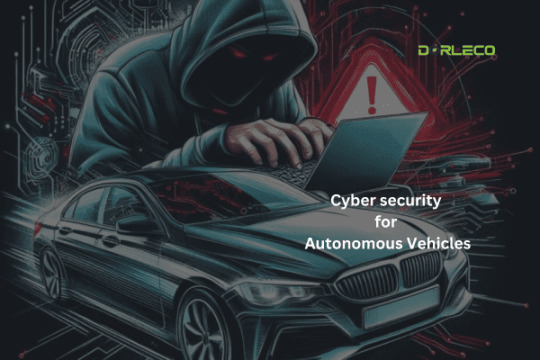
Autonomous vehicles, also called self-driving automobiles, are a revolutionary technological development in the automotive industry. These vehicles can decrease traffic, increase road safety, and generally improve travel conditions. However, since it was added to our highways, a new set of security problems has emerged. This introduction will provide an overview of cyber security for autonomous vehicles and emphasize the need to safeguard these innovative forms of mobility.
Cyber security for Autonomous Vehicles Is Critical
Data-Driven Operation: To make judgments in real time, autonomous cars mostly rely on communication networks and data. Any compromise to the availability or integrity of data could have severe effects.
Safety Concerns: If autonomous cars are compromised, there may be a risk to the safety of other drivers as well as passengers. Manipulating sensors or remotely controlling the vehicle’s functions can lead to accidents.
Privacy Issues: Autonomous cars collect a lot of data about the movements and activities of their occupants. This sensitive data needs to be safeguarded to maintain privacy.
Economic Impact: It is projected that the autonomous car market will reach a $1 trillion valuation. In this developing economy, cyber security breaches could result in monetary losses and damage public confidence.
Key Challenges for Cyber security for Autonomous Vehicles:
Vehicle Networks: Through intricate networks, autonomous cars can communicate with both other vehicles and the infrastructure. These networks must be secured to stop illegal access and data breaches.
Sensor Systems: LiDAR and cameras are two examples of sensors that are crucial for perception and navigation in sensor systems. These sensors can be used to fool the vehicle, which is dangerous.
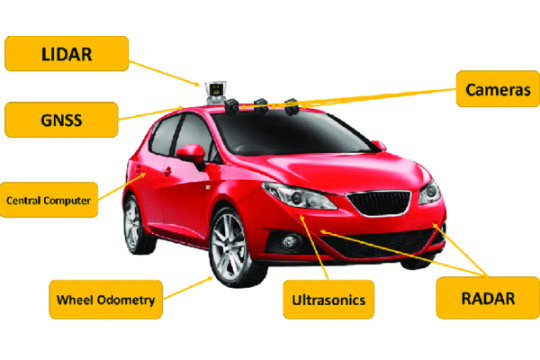
Applications Vulnerabilities: There could be problems with the intricate software systems that drive autonomous vehicles. Preventing exploits requires patching and software security.
Updates via Over-the-Air (OTA): Vehicle functionality and security are enhanced by OTA upgrades. It is crucial to confirm the legitimacy and dependability of these updates.
Mitigating Cyber Security Risks:
Encryption: Information should be encrypted both in transit and at rest to prevent data theft and eavesdropping.
Intrusion Detection Systems: Use cutting-edge intrusion detection systems to keep an eye on network activity and spot irregularities.
Firmware Validation and Secure Boot: To ensure that the car’s systems are running only certified firmware, employ secure boot methods.
Multi-Factor Authentication: To access vehicle systems and data, use robust authentication techniques like multi-factor authentication.
Cooperation and Regulation: To develop and put into effect industry norms and legislation, and foster collaboration among automakers, authorities, and cyber security experts.
Benefits of Cyber Security for Autonomous Vehicles
1. Cyber security for autonomous vehicles
It offers many advantages that are necessary to ensure the trustworthy and safe operation of these vehicles. The success and general acceptance of autonomous car technology, as well as the security of both passengers and the general public, depend on these advantages. The primary advantages of cyber security for self-driving cars are as follows:
Safety and Reliability: By defending against malicious cyber-attacks, cyber security solutions shield self-driving cars from having their essential operating systems compromised. Lowering the likelihood of unauthorized access, data theft, or tampering with vehicle functionality, increases safety.
Preventing Accidents: By preventing hackers from breaking into automotive controls or sensors, cyber security measures may reduce the risk of accidents. Ensuring the accuracy of decisions and preventing collisions requires maintaining the integrity of communication networks and sensor data.
2. Privacy of Data:
Preserving Personal Data: Self-driving vehicles gather copious amounts of data regarding the movements and actions of their passengers. Effective cyber security ensures that this sensitive data is kept private, protecting passenger privacy.
Compliance with Data Regulations: With data privacy rules like the CCPA and GDPR in effect, it is crucial to ensure that personal data in autonomous automobiles is secure to avoid legal repercussions.
3. Preserving Public Confidence:
Establishing Self-Assurance: Sustaining Public Trust: Public, manufacturer, and passenger trust are all fostered by a robust cyber security system. Passengers are more likely to embrace driverless vehicles if they believe that their safety and privacy are protected.
Sustaining Credibility: Manufacturers of general technology as well as autonomous car technologies run the danger of having a single cyber security incident tarnish their brand. Strong cyber security protects the industry’s standing.
4. Preventing Financial Loss:
Safeguarding Investments: Automakers, the car industry, and other stakeholders must invest a significant amount of money in autonomous vehicles. Cyber security helps to safeguard these investments by preventing security breaches and the associated financial losses.
Liabilities Reduction: Solutions for cyber security for autonomous vehicles may lessen the possibility of legal consequences from mishaps involving these vehicles or from privacy violations.
5. Fulfilling Industry Standards:
Adhering to Rules: Cyber security norms and laws must be followed in the development and deployment of autonomous vehicles. Compliance with these standards is often required by government bodies and industry associations.
Taking down Regulatory Obstacles: Good Cyber security for Autonomous Vehicles practices can speed up the commercialization of the technology by making it simpler for manufacturers of autonomous vehicles to adhere to legal requirements.
6. Safe Updates:
Over-the-air Updates: Updates are frequently transmitted over-the-air (OTA) in autonomous vehicles. These upgrades are safe and impenetrable thanks to cyber security. This stops software bugs and illegal changes.

7. Continuous Improvement:
Adaptability: Because cyber security is dynamic, new threats must be handled. Autonomous vehicle cyber security processes enable ongoing security protocol adjusting and enhancement.
Drawbacks for Cyber Security for Autonomous Vehicles
While cyber security for autonomous vehicles is essential for self-driving automobiles, implementing these safeguards has major challenges. It is crucial to be aware of these challenges to effectively address and reduce them. Some disadvantages of cyber security for self-driving cars are as follows:
Cost and Complexity: Implementing robust cyber security defenses may be costly and time-consuming. Due to the significant financial and human resources required to design, maintain, and upgrade security systems and protocols, the cost of producing autonomous vehicles may increase.
Impact on Performance: Certain cyber security solutions, including intrusion detection systems and encryption, may have a performance cost. This can affect the real-time decision-making capabilities of autonomous vehicles, which might lead to a delay in responding to emergencies.
Drawbacks/False Positives: Intrusion detection systems may inadvertently trigger false alarms or identify real threats. This can be a major issue since false alarms can result in unnecessary interventions or service disruptions, and neglected threats could have catastrophic consequences.
Regulatory Compliance: It may not always be easy to comply with regulations, even though doing so is required to ensure a minimum level of security. Conforming to different local regulations and standards can be challenging for producers when they change.
Resource constraints: It may be difficult for smaller or recently established enterprises in the autonomous vehicle industry to set aside enough money for efficient cybersecurity protocols. Their autos can have security issues as a result of this.
User Experience: Excessively strict cyber security measures may negatively impact the user experience. Excessive security measures, such as repeated identity reminders, can annoy passengers and deter them from utilizing autonomous vehicles.

Interoperability Problems: It can be difficult to make sure that different autonomous car technologies and parts are compatible with one another and follow cyber security laws. Attackers could profit from the weaknesses that incompatibility creates.
Conclusion:
To sum up, the field of cyber security for autonomous vehicles is vital and constantly developing, and it is essential to the smooth integration of self-driving cars into our transportation networks. Strong cyber security protections have numerous and far-reaching benefits, such as increased safety, data privacy, public trust, financial protection, regulatory compliance, and the ability to facilitate secure over-the-air updates. These benefits support the industry’s ongoing expansion and prosperity while also protecting drivers and other members of the public.
But it’s also critical to recognize the difficulties and drawbacks of integrating cyber security for autonomous vehicles. These difficulties highlight the necessity for a thorough and flexible approach to cyber security. These difficulties include rising complexity and cost, possible performance implications, and the need to strike a careful balance between innovation and security.
Collaboration between autonomous car makers, cyber security specialists, regulators, and stakeholders is needed to address these issues. To keep abreast of changing threats and weaknesses, constant research and development are required. It also highlights how crucial it is to have security solutions that improve user experience rather than impede it.
Making sure autonomous vehicles are safe from cyber-attacks is not just a technological but also a moral and societal obligation as they become a more and more important component of our transportation system. We can create safer, more dependable, and more efficient autonomous vehicles that benefit society as a whole by proactively tackling these issues and utilizing the benefits of cyber security for autonomous vehicles. The cornerstone of this project is cyber security, which ensures that the promise of self-driving cars can be fulfilled while lowering the dangers involved.
#autonomousvehicle#Cybersecurity#Advancedtechnology#VCU#EVSoftwareservice#evCODE#ADASCode#VCUSupplier#VCUManufacturer
0 notes
Text
Form Masks for Elementor PRO v1.2
Form Masks for Elementor PRO v1.2
[ad_1]
Mask shapes for Elementor create a custom control on the “Advanced” tab to configure the fields using the masks. This plugin requires Elementor Pro (widget form).
Info: https://codecanyon.net/item/form-masks-for-…mentor/25872641
Masks work with field types “text” and you write your own masks. Create a mask that you want for your fields!
Z form-masks-for-elementor-pro-1.2.zip S…
View On WordPress
0 notes
Text
What Are You Doing, LIF!

Jadi gini. Gatau juga sebenernya mesti ngapain. Yang pasti, otak saya setahun terakhir ini emang lagi random. Kondisi ini itu. Buah dari udah saking lamanya, selama berbulan – bulan, berseliweran di kepala. Udah males sebenernya kalau harus ngejelasin semua ini. Mau nulis aja bingung. Bingung gitu, harus mulai dari mana, ngebahas yang mana dulu, terus tujuannya juga ga ngerti buat apa. Entahlah. Rasanya berat aja gitu. Tapi iya gimana, mau ga mau harus ditulis sih. Biar segala pertanyaan yang ada di saya ataupun dari yang lain, bisa clear. Setidaknya bisa ngasih gambaranlah, tentang keanehan, yang terjadi sama kehidupan saya belakangan ini. Seharusnya dari kemaren – kemaren saya tulis ini. Tapi gatau kenapa. Baru kesampeannya, iya sekarang.
Setelah lama tak menyapa, menghilang entah kemana. Kali ini, saya akan secara khusus hanya bercerita tentang tahun 2015 yang lalu. Dimana di tahun itu, saya mengalami banyak kejadian yang luar biasa, yang endingnya pun ga ketebak bakal kaya gimana. Semua itu, berawal, ketika nekat, dengan sadarnya, memutuskan untuk keluar dari zona nyaman saya. Dan kala itu, iya caranya dengan hengkang dari bangku perkuliahan. Di sekitar bulan April 2015 kemaren.
Nah baru deh setelah keputusan itu. Semuanya seakan - akan berubah, selayaknya sambaran petir di siang bolong. Dan mungkin, itu sebuah pertanda, bahwa kehidupan kedua saya baru saja dimulai. Gatel asli, ingin segera dipaparin aja semuanya disini. Biar sekalian juga kan, jadi rekap data pribadi saya. Jadi pasca keputusan itu dan sudah menyandang status mantan anak kuliah. Maka dari itu, saya buatlah timeline target pribadi saya :

( Periode April – Mei 2015 ) Target #1 adalah recovery. Entah itu, recovery fisik serta recovery mental. Terus project yang ada, segera dituntaskan. Sama join seminar sebanyak – banyaknya.
Review : “Jadi kenapa targetnya recovery?”
Karena saya ngerasa, kalau performa diri saya lagi drop. Selama kuliah dari segi fisiknya sendiri, saya jadi lemah. Terus emang sering sakit – sakitan. Di diagnosa sakit asam lambunglah, sakit maag terus sakit typhus. Padahal waktu dulu sebelum kuliah nih, saya bukan tipikal orang yang gampangan sakit. Paling amandel sama gejala typhus. Itu juga udah lama, sekitar jaman SD – SMP. Gatau jugalah kemaren penyebabnya apa. Mungkin dari pola makan. Atau mungkin dari faktor kebahagiaan. Ditambah lagi, pernah juga cedera engkel karena kecelakaan dan sempet ga bisa jalan selama beberapa bulan. Itu baru fisiknya aja. Udah lumayan greget kan.
Belum lagi dari segi mentalnya, kondisi kepercayaan diri saya lagi goyah nih. Iya jadi kalau bisa. Berusaha terus dipacu semangatnya, motivasinya jangan sampe ilang, inget ada mimpi besar disana yang mesti dicapai. Tapi disisi lain, harus sabar juga. Terlebih ngehadepin cibiran – cibiran di luar sana sama social pressure yang begitu tinggi. Jadi, sebisa mungkin tetep survivelah. Terutama dengan kondisi – kondisi tak terduga yang kelak ada di depan. Serta siap sedia, menerima segala konsekuensi yang ada dan ngebuktiin juga ke orang – orang bahwa keputusan yang saya buat itu, ga salah.
Jadi iyaa minimal, saya harus ngembaliin lagi kondisi tubuh saya. Biar kembali fit. Dan di bulan ini, emang bener – bener lagi proses penyembuhan. Penyembuhannya lewat banyak cara, entah itu belajar ngatur pola makan, belajar jalan lagi, belajar ngenalin diri dan belajar apapun, yang bisa ngerubah diri saya jadi pribadi yang lebih baik lagi.
Ditambah, ada beberapa project juga yang sudah seharusnya segera diselesaikan. Nah kebetulan di bulan – bulan ini, saya handle 2 project, yaitu UK & PPI Online sama SMS Gateway Pengaduan Warga. Ada juga project dari Tour & Travel gitu. Sempet di iming – iming dapet fasilitas kantorlah, dapet mobil pinjamanlah, dapet ini, dapet itu. Plus, total projectnya itu loh sekitar 100 jtan. Gila.
“Siapa yang ga tergiur coba? Dapet project awal, nominalnya segede itu.”
Terlebih buat saya, orang yang baru dalam industri bisnis dan startup ini. Yang pasti udah berharaplah, udah meeting beberapa kali juga soalnya, paling, tinggal 1 atau 2 langkah lagi, menuju tanda tangan kontrak. Tapi iyaa, ujung – ujungnya mah da harkosss coy. Belum lagi, ada project yang lain juga, yang masih di follow up. Rezeki mah siapa yang tau, yang terpenting mah ikhtiar jalan terus. Terus emang lagi giat – giatnya aja, dateng ke seminar disana sini. Ceritanya mah, biar dapet channel gitu, biar belajar juga dari pengalaman orang lain. Sekalian berharap lah, dapet makan gratis wkwk
FYI ( Saya itu punya startup, yang dirintis bersama 2 teman saya semasa SMK yaitu Ismail sama Okky. Didirikan akhir tahun 2013, startup itu diberi nama EVCODE Indonesia. Baru juga beberapa bulan jalan. Tapi harus vakum untuk sementara waktu, dikarenakan sibuk UN dan lagi pada bingung nentuin nasib masing – masing setelah lulus. Jadi di awal tahun 2015, baru aktif kembali dan menyongsong tekad serta semangat yang baru. Dan telah merekrut 7 teman yang lainnya ).

( Periode Juni – Agustus 2015 ) Target #2 adalah nyari – nyari project baru. Terus kalau ada seminar dan waktunya bisa, iya ikut aja. Dan didesak biar segera buat landing page websitenya @evcode soalnya hostingnya udah ada. Tapi yang jadi fokus utama saya adalah punya product aplikasi sendiri.
Review : Alhamdulillah, kondisi tubuh ini sudah mulai membaik walaupun terkadang masih suka kambuh sih. Terus alhamdulillah juga dapet project baru yaitu Hot Spicy dan waktu itu, saya baru kebagian ngehandle webnya. Yaudah, saya kerjain aja. Saat itu, webnya udah nyampe prototype. Web statis – statis gitu lah. Paling tinggal diisi kontennya atau ada revisi dikit, kelar udah. Belum lagi, di periode kedua ini. Saya lagi handle landing pagenya @evcode. Tapi karena emang belum kepikiran aja konsepnya mau kaya gimana. Jadi solusi alternatifnya saat itu, iyaa dibuatin dulu aja dah web comingsoonnya @evcode.
Karena saya ngeubet banget pengen punya product. Iya jadi saya bela – belain gali ide sendiri, observasi sana – sini, hampir nyerah karena ga dapet – dapet ide juga, kerjain proposal sendiri, waktu juga udah mepet, pokoknya sibuk sendiri dah.
”Terus kenapa ngeubet sih, lif?”
Iya, soalnya kan, product itu identitas dari suatu startup. Kita itu startup. Tapi kalau ditanya product. Belum punya product? Gimana coba? Jadi. Buat apa kita bikin startup kalau ga punya product mah. Lah
“Emang bedanya product sama project, apa lif?“
Project tuh, kita bikin aplikasi tapi sesuai sama permintaan si klien. Jadi semuanya, iya terserah gimana klien. Dan ketika aplikasinya udah selesai, kita dapet bayaran. Biasanya, duitnya stop sampe disitu. Misal kaya aplikasi kasir noh yang ada di minimarket, atau ga bikin website buat perusahaan, dsbnya.
Nah kalau product, masih sama sih ngerjain aplikasi. Cuma kaya jadi ciri khas aja gitu dan punya hak milik sendiri. Gimana iya. Jadi kita tuh bikin aplikasi, yang ngesolve masalah, tapi pake inovasi ide sendiri. Nah biasanya, masalahnya tuh bersumber dari yang pernah dialamin. Atau ga, yang deket – deketlah. Terus entar di lempar ke pasar. Ditunggu feedbacknya gimana, diupdate, nunggu feedback lagi, diupdate lagi, iya gitu aja terus siklusnya. Entar dapet uangnya atau revenuenya, ketika orang – orang banyak yang pake aplikasi kita. Entah lewat cara iklankah, beli akun premiumlah, potongan pembayaran, bayar jasa, dsbnya. Iya, tergantung bisnis model aplikasinya kaya gimana. Contohnya banyaklah. Kaya sekarang, Traveloka, Bukapalak, Kitabisa, Instagram, Facebook, Twitter dan masih banyak lagi.
“Terus kenapa baru sekarang buat productnya, kemaren – kemaren kemana aja?”
Iya karena dulu – dulu. Niatnya @evcode masih nyari dana. Dana buat kontrakan rumah. Jadinya. Prioritasnya itu, malah nyari – nyari projectkan mulu dan terkesan mengabaikan product. Begitu.
“Emang buat apa sih kontrakan rumah?”
Gini. Kalau kontrakan rumah ini, fungsinya. Buat kantor lah. Atau ga buat tempat kita ngumpul gitu. Biar kalau ada project atau mau bikin product jadi gampang. Gampang buat ketemunya, gampang buat diskusinya, gampang buat sharingnya, dsbnya. Soalnya, selama kita ngejalanin startup ini. Kerasa bangetlah susahnya kalau ga ada basecamp. Emang jadi salah satu kendala terbesar sih. Apalagi kalau disuruh kumpul. Karena itu tadi, iya emang ga ada tempatnya. Jadi harus nentuin dulu. Waktunya kapan, tempatnya dimana. Sementara kan, tiap orang punya kesibukannya masing – masing. Belum lagi kalau udah ketemu, durasinya juga terbatas. Jadi buat bertatap langsung aja, cukup sulit bet. Beda halnya kan kalau ada basecamp. Tinggal dateng aja kapanpun, seenak jidat. Pasti ketemu da. Bisa nginep juga lagi.
“Jadi selama ini, ngerjainnya atau koordinasinya gimana?”
Iya paling lewat email, telpon, sms sama grup chat. Atau ga, minimal seminggu sekali diusahain lah buat ketemuan gitu. Entah itu, di foodcourt, di minimarket. Atau bahkan digilir di rumah temen. Sedih iya kaya refugee.
Alhasil, akhirnya dapet ide juga yaitu needit dan kebetulan saya jadi PMnya ( Product / Project Manager ). PM itu bisa dibilang ketua kelompoknya lah. Sebenernya sih, needit udah ada. Tapi konsep sama targetnya saya revisi total dari versi needit sebelumnya. Alhamdulillah membuahkan hasil, lolos tahap pertama proposal CompFest7.
Dan bulan puasa kali ini, mungkin bulan puasa paling berat sih. Iya karena baru pertama kalinya gitu, ngejalanin ibadah puasa dengan kondisi punya penyakit maag. Sungguh menyakitkan ternyata. Baru ngerasainlah gimana perihnya lambung ini. Misal, udah waktunya buka nih tapi selang 30 menit. Iya, kambuh lagi dah ini lambung. Shalat tarawih pun banyak yang sekip. Tersiksa gini bulan ramadhan teh.
Develop needit
Seusai bulan puasa, baru deh fokus lagi buat ngedevelop needit. Saya udah buat timeline developingnya kaya gimana, udah dijelasin dan udah bagi – bagi jobdesk juga ke yang lainnya. Selain sebagai PM, saya juga di needit punya peran lain yaitu sebagai UI & UX Designer. Ga sekeren bahasanya ko, biasa aja. Paling kerjaannya bikin design, sama nentuin kebiasaan apa yang bakal diterapin ke user di aplikasinya. Semua itu seakan – akan berjalan lancar. Tapi tidak ternyata. Setelah masuk 4 minggu masa developing, baru deh satu rahasia terbongkar. Banyak drama men, yang mulai terjadi disini. Okky yang ditunjuk sebagai Sang Developer, melakukan kesalahan fatal. Apalagi dengan kata – kata, tau beresnya itu. Secara pribadi, bikin sakit hatilah. Pokoknya bener – bener udah ngecewain. Dan bikin, plan saya jadi kacau balau. Walaupun sebenernya needit ini ambisi pribadi saya. Tapi, toh kan. Yang kena impactnya, buat kemajuan @evcode juga.
Akhirnya mau gamau, dengan waktu yang semakin terbatas harus berpikir keras. Deadline udah di depan mata coy. Gimana caranya, seolah - olah kita punya plan B. Yang dimana sebelumnya, emang ga kepikiran kalau kondisinya bakal berantakan kaya gini. Tapi alhamdulillahnya, ada jalan ternyata. Dan masih diberi kelancaran sama kesempatan juga sama Allah. Sebenernya sama sekali ga mudah, buat eksekusi plan B ini. Disinilah banyak keajaiban terwujud, effortnya kerasa banget. Warbiyasa. Makasih banyak juga, buat yang lainnya yang udah berkontribusi selama ini. Yang rela mondar – mandir kesana kesini, yang menyisihkan waktunya di sela – sela kesibukannya, yang ngabisin uangnya, tenaganya dan ngasih kamarnya jadi tempat boothcamp sederhana. Iya makasih banyak, saya sangat mengapresiasi itu. Disubmitlah needit apa adanya. Masalah lolos apa engga mah, terserah lah. Bebas. Segini juga udah syukur mau dikerjain.
Intinya sih di bulan – bulan ini, waktu saya abis. Abis, ngerjain develop needit. Buat landing page sama web comingsoonya @evcode. Belum lagi semasa developing needit. Pake acara too much drama segala lagi. Asli, benar – benar melelahkan. Bukan cuma fisik yang lelah tapi batin juga ikutan. Bikin satu product aja, susahnya minta ampun. Katanya startup, tapi mana? #jleb

( Periode September – Oktober 2015 ) Target #3 adalah fokus di jalur kompetisi.
Review : Oiya, alhamdulillah bulan ini dapet lagi project baru yaitu Brownies Manis App. Di project ini, saya kebagian handle designnya dan PMnya adalah Ismail Syababun Halim. Yaudah, tinggal dikerjain aja kan. Sempet terjadi misscom juga sebenernya.
“Karena, apanya?”
Mungkinn, efek saling tunggu satu sama lain sih. Sehingga, projectnya molor keenakkan. Dan saya ngerasa. Kalau kontribusi saya di project ini, emang ga terlalu banyak. Makanya kurang tau juga sih, ada cerita apa lagi dibalik project yang satu ini.
“Apakah sesedrama needit atau engga?”
Iya gatau juga, coba ditanya aja Mas PMnya. Biasanya sih, dia yang lebih banyak tau akan hal ini. Mungkin detail disetiap kejadiannya akan berkesan. Entah kesan baik ataupun buruk. Iya namanya juga PM, udah resikonya itu mah.
Kabar Baik & Buruk
Bulan september ini juga, emang lagi nunggu kabar. Pengumuman tim mana aja, yang lolos jadi finalis OpenApp Challenge CompFest7. Deg – deganlah, ga sabar juga dan emang cukup dinanti. Tapi akhirnya, kabar menggembirakan itu datang. Yaitu kita lolos masuk final dan berangkat ke UI. Wow, senengkan. Langsung sujud syukurlah, euforianya juga terasa. Di grup chat pun, udah pada rame dan udah ngomongin ini itu. Sebenernya inisiatif saya ikut kompetisi ini sih, biar terpacu aja gitu buat bikin product aplikasi. Karena kalau disengaja, suka susah dan yang ada malah ngaret tak beraturan. Jadi karena ada alesan deadline, biasanya mau gamau, suka ga suka, mesti dipaksa sih buat dikerjain walaupun berasa dikejar – kejar.
Tapi di hari itu juga, selang beberapa jam. Tiba – tiba kabar buruk pun menghampiri. Baru juga seneng dikit, sudah menderita lagi.
“Kaya diterbangin ke awan paling atas. Terus di atas, dibanting sekeras – kerasnya ke lapisan bumi paling dasar.” Sejenak, berasa kaya meteor jatuh..
Yang tadinya aura positif, langsung berubah 180 derajat menjadi aura negatif. Anti klimaks emang. Di grup chat pun, berubah drastis jadi pada marah – marah ga jelas. Kabar buruknya itu, Ismail di telepon sama klien project Hot Spicy. Dan cerita, kalau projectnya itu belum memenuhi kriteria. Sedangkan kewajiban pihak klien, katanya udah dipenuhi. Dan akhirnya pun, kita di tuduh melakukan penipuan. Yang paling parahnya lagi, @evcode mau di tuntut juga ke jalur hukum. Beuh... Cobaan apalagi ini ya Allah. Ngerjain product bermasalah, ngerjain project juga malah ikutan bermasalah. Gimana ini?
”Yang ada dipikiran saya waktu itu : Di penjara? Hah, emang salah apanya?”
Ga kebayang sih kalau emang bener jadi di penjara. Padahal sebagian besar dari kita, emang gatau apa – apa. Kabar terakhir sih yang kita dapet di bulan puasa pas bukber, bilangnya project Hot Spicy itu lagi dipending dulu. Jadi kurang tau juga, project ini tuh, udah berjalan sejauh mana. Makanya, sebagian besar dari kita emang agak shock waktu itu. Dari kita sendiri pun banyak pertanyaan yang muncul.
“Perasaan. Bukannya, projectnya itu dipending iya?” “Emang deadlinenya kapan sih?” “Masaa udah lama ga ada kabar, tau – tau komplain?”
Yang tau detailnya hanya seseorang. Karena dia emang PMnya, dia yang sering ketemu kliennya. Otomatis dia yang punya tanggung jawab penuh akan hal ini. Gataulah. Kronologi kejadiannya itu gimana. Saya pribadi heran, ko bisa gitu jadinya malah kaya gini. Kalau kita – kita sih, gamau suudzon juga. Dan yang pasti, saya gamau ngungkit – ngungkit cerita ini lebih dalam lagi. Soalnya udah masuk ranah privasi, men. Jadi yaudah iya. Kasus ditutup.
Imbasnya, ada keputusan besar yang diambil. Pokoknya ada pergantian formasi, melalui voting. Dan kebetulan, saya dikasih amanah sama temen – temen yang lain. Yang sebenernya ga pede juga. Apakah emang bisa atau engga mengemban amanah ini. Padahal rencana awalnya itu, mau ngebahas gitu. Gimana kelanjutan CompFest7 setelah masuk final tapi karena dapet masalah ini jadi agak ke distract dan bikin ngaret lagi yang pasti.
Seadanya
Dan seusai tragedi itu, kita lupain dulu sejenak dan kembali fokus ke persiapan entar final CompFest7. Karena emang, masih banyak juga kerjaan yang harus dikejar. Dengan kondisi yang keteteran, dimana aplikasinya belum maksimal. Masih banyak yang error, fiturnya masih banyak yang belum kelar, lagian waktunya juga udah terbatas. Yaudah, akhirnya bermodalkan tekad A.K.A nekat. Jadilah kita berangkat ke UI, tanggal 3 Oktober 2015. Yang berangkat itu, saya, Ismail, Eja sama Hardy. Mau entar disana kaya gimana, terserah Allahlah. Yang penting udah berusaha semaksimal mungkin daripada nyerah sebelum berperang kan. Yaudah, bismillah. Sebenernya pas H-1, sebelum hari keberangkatan pun dapet kendala lagi. Iya, mobil yang tadinya mau dipake, ternyata kaga bisa. Budget juga pas – pasan. Hmm, ada aja wehnya masalah teh. Yaudah, mau gimana lagi. Adanya bis, jadi kita naik bislah dari terminal Leuwi Panjang shubuh – shubuh. This is perjuangan, men!
Dan mau tau hasilnya gimana? Iya gagal. Belum berhasil ternyata. Awalnya emang belum ikhlas dan kecewa gitu. Apalagi pas tau ada kompetitor dari tim mana gitu. Cuma bikin aplikasi yang menurut saya, biasa aja gitu, gitu doang. Tapi juara lah. Sial. Di perjalanan pulang pun, suasana hening meliputi kondisi di bus malam itu. Padahal penumpang banyak. Cuma entah kenapa, semua penumpang seakan – akan terdiam dan menyesuaikan dengan kondisi hati kita disaat itu. Membuat saya memilih, untuk memasangkan headset dan memutar 1 buah lagu dari deretan playlist lagu yang ada.
“Ku tak selalu berdiri, terkadang hidup memilukan Jalan yang kulalui, untuk sekedar bercerita Pegang tanganku ini dan rasakan yang kuderita Apa yang kuberikan, tak pernah jadi kehidupan Semua yang ku inginkan menjauh dari kehidupan“
Iya. Kepingan lirik lagu tersebut terus bergema di telinga. Mungkin, lagu ini bisa menggambarkan perasaan saya kala itu. Menemani dengan setia, perjalanan panjang +160km hingga setibanya di Kota Bandung. Tapi iya mau gimana lagi, hasilnya emang begitu. Lagian, ga bisa dipaksain juga. Namanya juga kompetisi, ada yang menang, ada yang belum. Iya mungkin emang belum rezekinya aja. Toh segala persiapan juga, seadanya. Jadi bisa dibilang wajarlah. Pelajaran yang diambil dari sini sih, saya belajar tentang menghargai suatu proses.
Coba dipikir lagi. Nyampe final aja, sebenernya bukan target kita. Yang tadinya tugas persentasi itu siapa, mau gamau jadi saya. Yang dimana, saya ga begitu pandai dalam hal bercakap – cakap apalagi di depan banyak orang. Padahal, poin persentasi inilah yang bakal nentuin menang atau tidaknya di babak final ini. Persentasi yang cuma beberapa menit pun, terasa sangat lama. Dimana saya persentasi, sendirian. Nervous lagi. Keluar keringat dingin segala, ngomong pun udah terbata - bata, mata udah ga fokus, ngeliat kemana – mana, diliatin banyak orang, belum lagi aplikasinya error pas di running, gara – gara servernya down. Dasar, server gretongan! Down disaat yang tidak tepat. Udahlah. Pengalaman persentasi yang cukup berkesan. Bisa dianggap persentasi paling buruk, sepanjang pengalaman saya persentasi.
Terus yang tadinya handle codingan itu siapa. Jadinya malah Ismail. Karena emang dia satu – satunya yang bisa diandelin waktu itu.
“Percuma, ngarepin orang tapi orangnya ga bisa diharepin mah. Makanya gausah berharap!“
Walaupun Ismail lagi sibuk – sibuknya sama kegiatan kuliahnya tapi dia rela ngeluangin waktunya dengan serba keterbatasan yang ada. Belum lagi, bikin video demo aplikasi aja cuma sehari. Take video dari pagi sampe sore, editing beberapa jam, malemnya baru upload. Singkat, efektif, efisien. Berkat jasanya Eja nih, sang anak Fikom. Padahal sebenernya mah, udah mepet aja waktunya. Itu juga disempet – sempetin malah. Serta kontribusi – kontribusi menakjubkan lainnya.
Lalu, asa baru pun muncul. Karena seperti pepatah bilang “Gugur Satu, Tumbuh Seribu“. Iya soalnya kompetisi yang lain masih ada, mencoba move on lah ke kompetisi lain yaitu smartgeneration.id. Kebetulan proposalnya udah ada, tinggal edit – edit dikit paling. Yaudah, needit kita submit lagi. Iseng – iseng berhadiahlah. Jadi sekitar semingguan, emang lagi disibukkan dengan urusan ini. Belum lagi ada Hackathon IWIC 9, sebenernya. Cuma saya ga ikut untuk hackathon kali ini. Orangnya susah fokus pasti kalau ikutan hackathon mah. Yang ada malah liat kiri kanan, kerjaan ga kelar dah.
Buat yang belum tau. Hacktahon itu, semacam lomba bikin aplikasi selama 24 jam. Singkatan dari Hacking sama Marathon. Jadi si peserta pada dikumpulin di suatu ruangan gede dan dibagi menjadi perkelompok atau pertim. Biasanya sih, si peserta harus hadir di tempat saat lomba berlangsung. Aplikasinya pun beragam, bisa hanya desktop, mobile, website atau kombinasi ketiganya. Masalah apakah aplikasinya masih berupa ide dan dikerjain dari nol, atau setengah jadi, ataupun aplikasi udah jadi. Itu dibalikkin lagi, tergantung gimana regulasi dari si penyelenggara lombanya. Kurang lebih itu sih yang saya tau.
Menjadi Relawan
CompFest7 usai, Hackathon pun dimulai. Iya kalau ga salah, selang 3 minggu dari kepulangan di Depok. Diajaklah buat jadi relawan panitia Hackathon Merdeka 2.0 Bandung. Karena diajaknya jadi panitia, iya maulah walaupun acaranya Hackathon. Kalau diajaknya jadi peserta mah belum tentu mau da. Acaranya tuh dari tanggal 24 – 25 Oktober 2015, bertempat di BDV dan di 27 kota lainnya secara serentak. Kaya memperingati Sumpah Pemuda gitulah tapi ala developer. Sebenernya dari beberapa bulan sebelumnya, udah diajak sih. Sempet ada beberapa kali meeting juga. Tapi saya ikut meetingnya cuma sekali. Jadi pas tinggal H-1, baru deh diajakin lagi. Yaudah caw aja, jarang – jarang dapet kesempatan langka kaya gini coba. Jadi panitia lagi, mending sikat aja dah. Disana tuh, ketemu orang – orang kece terutama di bidang IT. Ada yang udah ini, ada yang udah itu lah. Kerenlah. Pengalamannya paling. Bisa kenal sama banyak orang terutama anak – anak Fowab, bisa nginep di BDV 3 hari 2 malem, terus ngomong kalimat yang sama tapi diulang – ulang ke semua peserta, jualan martabak wkwk, dipercaya jadi leader, bolak – balik naik turun lift, kaki pegel – pegel dan lain – lainnya. Seru bet. Dapet pengalaman baru ceunah.
Tapi bete. Pas pulangnya malah ke jebak sama Bobotoh Viking yang lagi konvoi. Dari jalan Pelajar Pejuang nih sampe Cileunyi, ga putus – putuslah. Yang tadinya pengen cepet nyampe rumah, malah jadi kaya gini. Padahal bus Persibnya dimana, konvoinya dimana. Hadeuh.
FYI : karena kebetulan, disaat yang bersaaman. Waktu itu bertepatan dengan hajatan Persib selepas menjuarai Piala Presiden 2015.

( Periode November – Januari ) Target #4 adalah jalanin dulu yang ada dan memperbaiki kondisi @evcode dengan semampunya.
Review : Di awal november ini kondisi @evcode emang kurang kondusif. Dan saya punya tanggung jawab buat memperbaiki kondisi itu. Tapi yang pasti smartgeneration.id yang bulan lalu disubmit, lolos tahap 1 dan persentasi di ITB tanggal 14 November 2015. Waktu itu yang jadi konfirmasi dateng, saya sama Ojak. Persentasinya sih cukup lancar. Cuma dasar. Pas giliran running aplikasi, biasa, malah error lagi lah kaya yang CompFest7 kemaren. Anjir sial mulu. Yaudah, feeling ga lolos lagi kayanya mah. Dan emang ga lolos men. Saat itu juga, seusai persentasi. Saya sempet cerita ke Ojak sembari menikmati hidangan kupat sayur dipinggir jalan, di sebrang gerbang masuk utama ITB.
“Jak, ini @evcode mau gimana?” Gatau lif, jawab Ojak kala itu dan percakapan pun berlanjut, bla, bla...
Setelah bencana besar menimpa, CompFest7 gagal, udah mancing – mancing diskusi di grup pada ga bales cuma direaddoang, akhirnya pada mangkir pas meeting rutin mingguan, ego setiap orang mulai keliatan. Udah... Tinggal menunggu waktu aja ini mah, kapan kehancuran itu datang. Soalnya emang semenjak bencana besar itu datang, udah keliatan lah tanda demi tanda yang mengarah kesana. Dan akhirnya kejadian, bem!
Bete.
Urang bete dan cape, ngajak meeting berkali – kali tapi dibatalin mulu. Dan kebetean itu memuncak. Pas giliran udah fix meeting, eh pas saya dateng ke tempat meetingnya ga ada yang dateng satu orang punlah. Sedih. Yaudah pulang lagi ke rumah tanpa hasil. Dan sepanjang jalan dari Bubat ke Rancaekek cuma bisa ngedumel. Kalau menurut persepsi dan suudzon saya, kaya mereka tuh udah disibukkan sendiri sama aktivitasnya masing – masing. Dan ngasih kesan kalau @evcode itu, udah bukan prioritasnya mereka lagi. Dari situ, saya ngerasa, kaya ditinggalin aja gitu sendirian. Saya tau, mereka emang orang - orang sibuk. Tapi setidaknya kalau @evcode masih jadi prioritas luanginlah waktunya beberapa menit, ga lama ko. Itu juga cuma seminggu sekali.
Gatau dah. Apa saya yang salah. Yang mungkin kebanyakan mikirin @evcode atau saya yang terlalu sensi atau gimana. Seketika itu saya tersadar. Mungkin selama ini, saya emang terlalu fokus sama 1 kaki penopang. Yaitu @evcode. Dimana, bukannya nyari kesibukan lain atau ngejar mimpi yang lain, yang mungkin bisa jadi penopang tambahan. Jadi ketika @evcode hancur, yaudah. Otomatis saya ga punya penopang, saya ga punya value dan ga punya apa – apa. Dari situ, mulai mikir.
“Ayo LIF sudah waktunya meniti karir sendiri, diatas kaki sendiri, tanpa embel – embel apapun, tanpa bantuan siapapun!”
Maksudnya tuh, kan dulu berkelompok. Jadi kesannya kaya ketergantungan dan ngandelin orang lain gitu. Kalau ada kekurangan dari salah satu pihak, bisa saling backup kan. Nah sedangkan sekarang, posisinya udah beda, udah sendiri. Jadi diusahain lah kalau ada kekurangan atau apa, ditelen aja sendiri. Mau manis ke, mau asin ke, mau pahit ke, yaudah dinikmatin aja.
Akhirnya langkah pertama yang saya ambil adalah coba ikut Lomba Infografis Korupsi Sumber Daya Alam Indonesia dari Prung Grafis di bulan November 2015. Dalam rangkaian acara Festival Antikorupsi Bandung 2015. Saya kerjain itu, kurang lebih 2 mingguan dan selesai di batas akhir penutupan. Mepet dasar. Partisipasi saya di lomba ini tuh kaya tolak ukur aja gitu. Apakah bisa, apa engga, bikin suatu karya? Dan hasilnya, jeng jeng…
Alhamdulillah masuk nominasi 20 besar. Ternyata… “Siapa saya coba?” Terutama di bidang Design Grafis.
Kuliah bukan jurusan design, belajar juga jarang jarang, pengalaman ga ada. Jadi pake ilmu seadanya weh dan ngikutin kata hati aja. Dan karyanya sempet dipamerin juga di Alun – Alun Kota Bandung selama 1 mingguan. Yang pasti bersyukur dan tersanjung sih bisa kepilih dari 130an lebih karya, bisa masuk 20 besar, walaupun ga juara tapi tak apa.
Tapi harapan kecil kepengen jadi juara sih, iya ada. Siapa gitu yang ga pengen juara. Spesialis nominasi mulu nih soalnya. Kapan iya bisa mecahin telor. INAICTA 2013 nominasi, CompFest7 finalis, nah sekarang ini Prung Grafis-Infografis nominasi juga. Minimal kalau infografis ini juara, bisalah buat ngobatin kekecewaan saya sama kegagalan yang @evcode alami. Sekaligus bisa sombong lah ke orang – orang. Soalnya kalau nominasi doang mah suka ga dianggep padahal sama – sama prestasi juga.
“Sempet frustasi sih, kapan gitu saya bisa jadi sang juara dan bikin bangga orang tua?”
Entah Kenapa, Jadi Baper & Kepikiran
“Iya iya, perasaan kenapa saya gagal mulu iya?” “Bikin startup, gagal. Ikut lomba, ga juara.” “Rasanya lelah aja gitu. Harus berapa lama lagi, saya menunggu dan bersabar?” “Kapan gitu, saya bisa buktiin ke orang – orang?”
Akhirnya di bulan desemberan, dikala umur mau menginjak 19 tahun. Yang ada malah stress. Stress lah. Frustasi. Bahkan sempet kepikiran juga, mau bunuh diri. Kesel gitu sama apa yang terjadi. Berasa hidup di dunia ini, ga ada adil – adilnya lah buat urang. Kayanya lebih baik di akhirat deh. Iya. Katanya kan sistem penilaian akhirat itu, menjanjikan keadilan yang seadil – adilnya. Jadi ketika urang ngelakuin kesalahan, yang urang dapet iya hukuman. Namun ketika urang ngelakuin kebaikan, yang urang dapet iya pahala.
Urang tuh udah usaha sekeras – kerasnya, padahal. Doa juga udah. Apa urang ga direstuin gitu atau dosa urang banyak teuing. Bikin startup, baru juga sekitar 10 bulan jalan. Yang ada malah ancur, babak belur. Banyak yang urang investasiin di startup tuh. Inves materi yang lumayanlah bagi kalangan pelajar miskin kaya urang mah. Kalau dikira – kira ada mungkin sekitar 2,5jtan mah. Entah dipake buat bayar projectkan atau biaya operasional lainnya. Dan duit itu tuh, emang duit urang pribadi bukan minta ke orang tua atau pinjem – pinjem ke orang lain. Tapi duit hasil nabung urang, selama masa - masa sekolah. Alhasil ga ada duit lagi di tabungan. Kosong, hampa tak bersisa. Belum termasuk gaji urang, yang sekitar 3,5jtan, yang gatau nasibnya gimana. Inves tenaga sama waktu, iya apalagi. Udah jelas itu mah. Tapi bukan bermaksud jadi so perhitungan atau gimana. Tapi masalahnya, udah segitu banyak gitu yang diusahain, yang dikorbanin, yang diperjuangin. Tapi ga ada hasil coba. Prestasi ga ada, karya ga kelar.
Seperti jejak kaki, yang dipinggir pantai, yang digerus ombak. Lenyap sudah.
Apalagi bagi orang – orang yang hanya tau, urang adalah seorang anak kuliahan yang tiba - tiba maen keluar gitu aja. Makin enak aja gitu, buat mereka ngelabeli urang pengganguranlah, pemalesan, mau jadi apa sih dan pandangan – pandangan negatif lainnya. Padahal mah, gatau juga kan kenapa keluar? Terus gatau juga kan, track record urang kaya gimana? Gila, gampang banget ngomongnya, main judge aja. Kesannya tuh kaya hina banget gitu, urang.
Gini, urang kira. Dalam sebulan itu, minimal dapet 1 project lah. Misal, urang dapet gaji 1jt dari 1 project. Jadi urang buat perhitungan kaya gini. Urang keluar kuliah kan dari bulan April. Sedangkan sampe akhir tahun itu, ada jangka waktu sekitar 8 bulan. Jadi maksimal, urang bisa dapet 8jt. Iya paling parah, 3jtan atau ga 4jtan gitu. Tuh. Lumayan kan. Dan faktanya, di bulan September udah ngerjain 3 project berarti 3jt lah, udah dapet tuh. Belum, ada beberapa project juga yang masih negosiasi. Belum lagi, kalau CompFest juara. Belum lagi, kalau investor yang waktu itu nerima. Udah. Dapet berapa puluh juta tuh. Target pribadi kecapai, target startup kecapai.
Tapi kalau ujung – ujungnya kaya gini mah, hasrat tidak tersalurkan. Iya minimal dapet gajinya gitu. Rencananya bulan desember ini tuh mau soft launching dan perkenalan keluarga gitu. Tapi mana? Hasilnya mana? Ga ada. Padahal harapan urang gede banget sama @evcode ini. Kalau diibaratin, @evcode tuh kaya kendaraan urang lah buat wujudin sebagian mimpi urang. Umur udah 19 nih tapi mana.
“Kesambet, apa, gitu, dikit. Udah. Urang langsung koslet da.“
Waktu itu juga, urang marah sama Allah. Kenapa coba, endingnya ko jadi kaya gini?
Urang keluar kuliah tadinya kan mau bikin prestasi lewat startup. Tapi entah kenapa, yang ada, malah semua usaha yang urang lakuin, jadi ga keliatan apa – apa. Kampret.
Ditambah. Semua barang – barang yang urang punya pun rusak secara bertahap, satu persatu. Mulai dari hplah, modemlah, laptoplah sampe ke headset - headset segala, pada kompakkan bersatu padu untuk makin memperkeruh suasana. Kaya emang pertanda aja gitu, kalau awan hitam pekat lagi menaungi urang saat itu. Dengan kondisi yang kaya gini, makin memaksa urang lah buat menghilang dari peradaban. Bingung asli mesti ngapain.
“Dicari – cari, dimana salahnya gitu? Ga nemu.“ “Urang pun ragu. Apa masih sanggup gitu buat ngelanjutin hidup?“ “Dan apakah, langkah urang buat keluar dari zona nyaman adalah blunder telak?“ “Jadinya nyesel gitu lif karena udah ngelakuin ini?“



UK & PPI Online Mobile Version : disini Website Comingsoon @evcode : disini Hot Spicy Website : disini Landing Page @evcode : disini Proposal, Dokumentasi needit : disini Landing Page needit : disini PrungGrafis Korupsi SDA Indonesia : disini 20 Terbaik Lomba Infografis PrungGrafis : disini
*note : Ini tuh bukan sebuah pembelaan diri atau bahkan pencitraan. Toh citra urang udah jelek ini. Iyaa hanya sedikit bercerita saja tentang sepenggal pengalaman hidup saya. Yang dimana diambil berdasarkan perspektif diri saya. Jadi kalau ada yang salah – salah, yang mungkin ngerasa kesinggung atau sakit hati atau gimana. Saya dengan lapang dada minta maaf.
Yang jelas, kemungkinan besarnya sih, bakal ada part lanjutannya. Dimana di part lanjutannya ini, bakal di kumpas tuntas abis tanpa cela. Kenapa dan kenapa iya. Pertanyaan demi pertanyaan, yang sekiranya mengganjal, bakal terjawab. Cuma iya, entah kapan kelarnya. Sekian dan terimakasih.
2 notes
·
View notes
Text
청정바다가 펼쳐진 거제여행 바람의 언덕·신선대·해금강테마파크
http://www.prugio.com/webzine/201702/sub02-001.asp?EVCODE=5315
0 notes
Text
Technology Advancement in the Automotive Industry
August 30, 2024
by dorleco
with no comment
Autonomous Vehicle Technology
Edit
Introduction

Automobile manufacturers assemble vehicles such as cars, trucks, and motorcycles at vehicle build facilities. It is also known as a production plant or assembly factory for automobiles. To build a fully functional car, this process involves assembling many parts, such as the engine, chassis, body, and interior. Vehicle construction facilities are critical to mass production in the automobile industry.
The following are important components and stages frequently observed in the automotive industry:
Body Shop: This is the place where an automobile’s frame or chassis is assembled. Robotic welders and automated technologies are often used to connect the various components that comprise an automobile’s structure.
Paint Shop: After the body is built, it is brought to the paint shop. This is the stage where the vehicle undergoes numerous processes, including washing, priming, painting, and sealing. Sophisticated robotic technology is often used for precise painting.
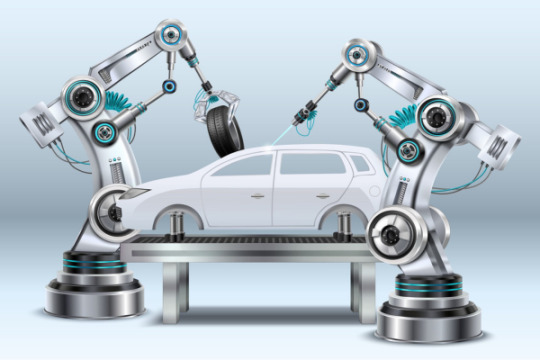
Quality Control: Inspections for quality control are carried out at different points during the assembly process to ensure that each vehicle meets the required standards. This may involve the employment of both automated systems and human examination.
Testing: Some facilities perform a range of tests to ensure the vehicle’s safety and performance. This could include quality control inspections, road tests, and functionality tests.
Packaging and Shipping: After passing all tests and inspections, the finished cars are prepared for shipment. This covers the stages of packaging, loading into transport vehicles, and delivering to stores or warehouses.
Advantages of Technology Advancement in the Automotive Industry
An automotive assembly factory sometimes referred to as a vehicle build facility, can benefit the automotive industry, the economy, and society at large. Here are a few key benefits:
Economic Impact: Vehicle manufacturing facilities have a significant positive economic impact by creating jobs and promoting the economy. Many individuals work in the automobile industry, not just in assembly facilities but also in related fields including suppliers, logistics, and support services.
Efficiency of Mass manufacturing: Assembly plants enable mass manufacturing, which enables the inexpensive and efficient fabrication of a large number of cars. As a result of the ensuing economies of scale, consumer prices for cars have decreased.
Standardization and Quality Control: Automotive manufacturing facilities employ stringent quality control protocols in addition to standardized practices. This helps to maintain high standards for the manufactured cars and ensures consistency in the production process.
Integration of Innovation and Technology: Automotive assembly plants often employ cutting-edge innovations and technologies. To increase efficiency, precision, and the ability to add new features and materials to autos, automation, robots, and advanced production techniques are applied.
Integration of the Supply Chain: Manufacturers of auto parts and materials are part of a bigger supply chain that also includes auto assembly plants. This integration ensures a steady supply of parts and reduces lead times by better coordinating and optimizing the entire production process.
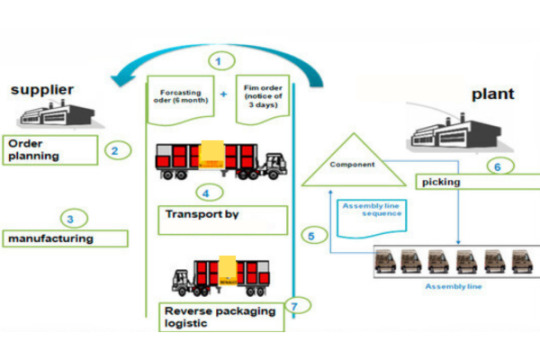
Local and International Trade: The capacity to manufacture cars in a particular region fosters both local and global trade. Completed cars can be exported to other countries, promoting global trade balances and economic interdependence.
Technological Advancements: Vehicle production facilities in the automotive industry often lead the way in terms of technological advancements. Research and development efforts at these institutions produce new technologies, safety features, and environmental advantages in cars.
Environmental Aspects: A few modern auto factories employ sustainable and environmentally friendly practices. Utilizing recycled materials, cutting waste, and employing energy-efficient processes can help the car industry become more ecologically friendly.
Consumer Access to Diverse Models: Through mass production in auto manufacturing facilities, a vast array of car models with different features, styles, and price points are made available to consumers. Customers with different demands and tastes are catered to by this variety.
Regional Development: The building of vehicle build facilities can support regional development by attracting related industries, creating a network of suppliers, and promoting the growth of ancillary services like retail, repair, and transportation.
Effects on the Technology Advancement in the Automotive Industry
Automobile manufacturing operations are not without issues and drawbacks, despite their many benefits. Here are a few potential drawbacks:
Environmental impact: The energy used, pollutants, and waste generated during the manufacturing of automobiles can have a significant impact on the environment. Even with initiatives to implement sustainable practices, the overall environmental effect of the car industry remains a problem.
Resource Intensity: The production of autos requires a substantial amount of raw materials, water, and energy. The extraction and processing of these materials could damage the environment and deplete natural resources.
High Initial Capital Expense: Establishing and maintaining a car manufacturing facility comes with a hefty upfront cost. Development of labor, infrastructure, land, and technology can be expensive.
Labor Issues: Labour-intensive industries like the auto industry may be threatened by strikes, disputes, and discontent among employees. There could be disruptions to production schedules and a decline in overall output.
Technological Obsolescence: Because of the rapid pace of Technology Advancement in the Automotive Industry, many production technologies may become antiquated. Research and development must be consistently supported to remain competitive and implement the most recent innovations.
Market Volatility: The Automotive Industry sector may be impacted by changes in legislation, consumer preferences, and the status of the economy. Changes in the demand for particular car models or economic downturns can have an impact on the production volume and profitability of automotive manufacturing plants.
Energy Consumption: Despite efforts to adopt more energy-efficient techniques, the production of automobiles is still very energy-intensive. The automotive industry’s use of non-renewable energy sources has an impact on its overall carbon footprint.
Waste Generation: A variety of wastes, including materials, chemicals, and by-products, are produced during the production process. Effective waste disposal and management are essential for minimizing the impact on the environment. Programs focused on minimizing trash and recycling might have challenges, though.

Land Use and Urbanization: The development of vehicular facilities typically requires large land parcels, which may lead to urbanization and the potential displacement of natural habitats. The local ecosystems and biodiversity may be impacted by this.
Conclusion:
To sum up, car manufacturing plants are essential to the automotive sector and have a major impact on commerce, economic expansion, and technological development. These factories’ capacity for mass production increases consumer access to automobiles and promotes a wide range of car models and features. Notwithstanding these benefits, there are still difficulties and disadvantages, from labor disputes and market volatility to resource intensity and environmental problems.
The automobile sector is emphasizing supply chain resilience, technological innovation, and sustainable practices to overcome these issues. Ongoing initiatives are to lessen the influence on the environment, increase energy efficiency, and use environmentally friendly production techniques. Furthermore, increased productivity, accuracy, and safety in the assembly line are brought about by advancements in robots and automation.
Maintaining a focus on worker welfare, appropriate resource management, and environmental sustainability will be crucial as the automotive industry develops. Car manufacturing facilities’ long-term viability and adaptability in a constantly shifting global environment depend on striking a balance between economic interests and environmental and social concerns. The future of car manufacturing will be shaped by the continuous dedication to research and development and the legal frameworks that support ethical behavior. This will guarantee a peaceful coexistence with the environment and society at large.
#autonomousvehicle#EVCharging#Advancedtechnology#robotsautomation#VCU#EVSoftwareservice#evCODE#ADASCode#VCUSupplier#VCUManufacturer
0 notes
Text
What is Bidirectional EV charging and How Does It Help Electric Vehicle Owners?
August 28, 2024
by dorleco
with no comment
Others
Edit
Introduction

Power safety shutdowns have left millions of Californians without energy to lower the state’s danger of wildfires. Many owners of electric vehicles (EVs) have been annoyed by their inability to use the electricity in their car batteries to power their houses or other important loads. Their EV batteries could store energy, but since they could only use the electricity to run their car, they could not benefit from bidirectional EV charging.
A growing number of electric vehicle (EV) owners can power heavy loads with their cars or by purchasing a wall box unit. Bidirectional charging systems have several benefits for both residential and commercial utility companies. To respond to questions from potential solar customers, one must be well-versed in the functioning of bidirectional chargers. Bidirectional electric car charging is an excellent approach to supply emergency power during a blackout without requiring batteries.
Bidirectional charging is very popular these days, and this trend will only grow as EVs become more capable. Consequently, several automakers have announced that they will supply automobiles with bidirectional capability, including Ford, Hyundai, Lucid, and Tesla.
Bidirectional EV charging: What Is It?

As the name suggests, bidirectional EV charging charges the battery and supplies electricity to other loads as needed by utilizing both the grid and the battery. An EV can help power a home, company, utility grid, other vehicle, or specific loads by utilizing bidirectional charging.
Now that the Nissan Leaf can charge in both directions, using this electricity for residential requirements requires setting up a power supply center inside the house.
The Ford 150 Lightning can provide 9.6 kW of power to a home’s electrical system for a few days. This arrangement requires Ford’s Charge Station Pro and a 100-amp circuit. Furthermore, the Hyundai Ioniq 5 and 6 have a power output of 3.6 kW.
How does it function?
A bidirectional EV charger is an advanced EV charger that can charge in both directions, as opposed to conventional unidirectional EV chargers that use AC power. Even though it looks simple enough, there is a complicated process involved in converting power from AC (alternating current) to DC (direct current).
Unlike traditional EV chargers, bidirectional EV charging converts AC to DC while charging and the other way around when discharging, much like an inverter. However, bidirectional chargers are only compatible with vehicles that can be charged in both directions using DC power. Unfortunately, there are currently very few EVs that have dual-directional charging capabilities; the most well-known example is the Nissan Leaf from later versions. Bidirectional chargers are also substantially more expensive than normal EV chargers because of their higher level of sophistication, which is achieved by using complex power conversion devices to control the energy flow to and from the automobile.
Beyond only powering a habitation, bidirectional EV chargers are equipped with technology that can manage loads and isolate a home from the grid during an outage, a procedure referred to as an island. The fundamental working principle of bidirectional EV chargers and bidirectional inverters, which have been used for backup power in home battery storage systems for more than 10 years, is extremely similar.
How Does Bidirectional EV Charging Work?
Alternating current (AC) power from the grid creates direct current (DC) voltage when the car is charging. Drivers of electric vehicles (EVs) can then use the energy stored in the battery to refuel the grid or power a dwelling. For this to happen, the electricity needs to be converted from DC to AC. Either the car’s converter or the charger itself does this.
One such product is the Wallbox Quasar, a home bidirectional DC charger. It features a CHAdeMO or CCS Type 1 connector in addition to an app with certain energy management features.
When accessible, V2G capabilities enable sustainable energy sources like solar and wind power to be used to charge the batteries of electric vehicles. Subsequently, the EV reduces greenhouse gas emissions by using its batteries to augment the grid’s power supply when not in use.
1. Vehicle to Home (V2H)
This technique allows an electric car to use its electrical panel to power a home or place of business; it’s especially helpful during a blackout. Additionally, homeowners who pay time-of-use rates could save money by using their EV battery during times of high energy demand and charging it during times of lower electricity rates.
The power control system of an EV with V2H capability must be connected to the home’s electrical distribution center for the house to receive electricity from the vehicle. After that, the car must be plugged into the charger to use electricity.
2. Vehicle To Load (V2L)
Vehicles with V2L capability come with an integrated DC-to-AC converter and a standard power outlet. By plugging in their loads, it enables customers to utilize the battery’s power. These features are found in EVs such as the Tesla Cybertruck, Hyundai Ioniq, Ford F150 Lightning, Kia EV6, and Rivian R1T.
3. Vehicle to Vehicle (V2V)
Unfortunately, EVs’ range limits how far they can go between recharging. The capacity of the EV battery, the efficiency of the car, and the ambient temperature all affect the range of the vehicle. V2V charging helps reduce range anxiety by enabling one EV to partially supply electricity to another.
What Benefits Can Bidirectional Charging Provide?

The ability to use the EV battery for other reasons can be very beneficial for utility companies and electric vehicle drivers alike. In actuality, EVs might contribute significantly to the grid’s decarbonization in the future.
1. Potential Energy Bill Savings
The price of power changes throughout the day based on demand if the local utility offers time-of-use rates. Over the summer, weekday afternoons and early evenings are when energy bills are highest and lowest, respectively, in the middle of the night. Therefore, using the grid or solar panels to deliver power during peak demand times and charging during off-peak hours is more economical.
2. Reserve Power for Outages
A few notable power outages have occurred in the last year or so, including the Texas Power Crisis in 2021 and the public safety power shutdowns in California that left millions of people without power. EVs with V2H capabilities can power an entire house during a utility outage. The capacity and state of charge of an electric vehicle’s (EV) battery determines how long and how many loads it can power a residence.
3. Not found in the Grid Energy
EVs with V2L capabilities can power specific loads by plugging into an outlet. If you’re camping or living somewhere without utility electricity, this can work out to be a good option. On construction sites, for instance, power tools can be used by artisans.
What Consequences Are There for Bidirectional EV Chargers?
While bidirectional EV charging offers many benefits, there are drawbacks as well. With more investigation, these obstacles can be addressed.
1. The Decline of EV Batteries:
Bidirectional EV charging involves repeated cycles of charge and discharge, which may shorten the total life of electric car batteries and hasten battery deterioration.
2. The Cost and intricacy:
Because it requires specific infrastructure and equipment, bidirectional EV charging increases the complexity and cost of both the electric car and the charging station.
3. Vehicles with Limited Interoperability:
All-electric vehicles can’t currently be charged in both directions using EVs. The fact that the technology is limited to compatible models of electric vehicles prevents it from being widely adopted.
4. Issues with Grid Stability:
Since vehicles that are charging in both directions can drain or return electricity at any time, the electric grid becomes more unpredictable. As a result, grid operators might find it challenging to maintain reliability and stability.
5. Concerns about Regulation and Standardization:
The absence of established standards and procedures for bidirectional charging could make it more difficult for different charging stations to communicate with one another and prevent the widespread use of electric vehicles.
6. Losses of Energy:
During the conversion and transfer process from the electric vehicle to the grid, energy is lost. When compared to unidirectional charging, this lowers the overall efficiency of bidirectional charging.
Which Electric Cars Are Dual-Charging Capable?
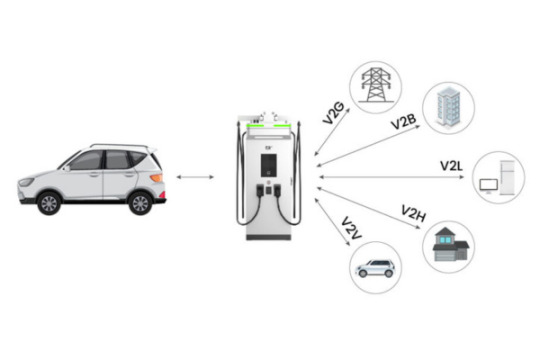
Bidirectional EV charging is only included in a tiny portion of EVs sold in the US; vehicle-to-grid charging is the most common. These vehicles have two-way charging installed:
Ford Lightning (V2H, V2V, and V2G versions)
Genesis GV60 (V2L)
V2L Hyundai Ioniq 5
V2L Hyundai Ioniq 6
Kia EV6 (V2L)
Kia Niro (V2L)
Air Lucid (V2V)
The V2L Mitsubishi Outlander PHEV
Leaf from Nissan (V2H, V2G)
V2L Tesla Cybertruck
VW ID.4 (V2H)
FAQs about Dual-Way Power Supply
Continue reading to get the answers to some of the most common questions about EV two-way charging.
What benefits does bi-directional charging offer EV drivers?
Bidirectional charging provides electric car owners with power, converting their vehicles into flexible energy sources. In addition to standard charging, this technology enables owners to potentially make money by selling extra energy back to the grid. Because of bidirectional EV charging, electric cars can also momentarily powerhouses or other EVs during emergencies.
Do all-electric vehicles have bi-directional EV chargers installed?
No, not all-electric vehicles on the road now are equipped with bidirectional EV charging. Compatibility is determined by the car’s design and whether or not it has the necessary hardware and software for two-way energy transfer.
What issues do EV batteries encounter when charging in both directions?
Bidirectional charging may reduce the overall lifespan of batteries used in electric vehicles by speeding up battery degradation because it increases the frequency of charge and discharge cycles. An EV battery’s longevity will only be materially impacted by heavy, regular use; in other cases, battery degradation is insignificant.
Can bi-directional EV chargers take the place of solar batteries?
While electric automobiles can store excess energy for use at home thanks to bidirectional charging, solar batteries are still required in some circumstances. The primary battery used in bidirectional charging in vehicles may not have sufficient capacity for large-scale energy storage. Solar batteries are more suited for storing solar panel energy to create a consistent and reliable power source because they have a larger storage capacity due to their stationary design. Furthermore, EV drivers may be reluctant to completely drain their batteries during blackouts due to the possibility that it will limit their mobility.
What is true about bidirectional charging?
Bidirectional EV chargers allow power to flow in two directions, in contrast to standard EV charging systems, which only allow power to flow from a power source to the vehicle’s battery. Electric vehicles, permit energy transfer and receiving, enabling them to share power with other gadgets or even the utility grid.
The Clean Energy Sector Could Be Transformed by Two-Way Charging
The way energy is consumed could drastically change if electric vehicles can send excess energy to the grid, other cars, or homes. The dynamic and decentralized approach that is presented by the interaction between electric vehicles and the energy ecosystem has the potential to improve grid management efficiency, improve resilience in the event of an outage, and even use electric vehicles as distributed energy resources. All of these benefits will help to create a more sustainable and flexible energy landscape.
By transforming high-power DC from the fast-charging station into appropriate power levels for various battery chemistries, the DC-DC converter complies with fast-charging regulations. This aids in the VCU’s optimization of charging speed while upholding security.
The DC-DC converter helps the VCU by controlling and transforming electrical power, making sure that fast charging is handled correctly, safely, and without sacrificing the performance or safety of the vehicle.
Explore our advanced fast-charging VCU products and stay connected to cutting-edge EV software services. For more information or inquiries, feel free to reach out to us at [email protected]. We look forward to serving you!
#autonomousvehicle#EVCharging#Bidirectionalcharging#testing#VCU#EVSoftwareservice#evCODE#ADASCode#VCUSupplier#VCUManufacturer
0 notes
Text
Autonomous Vehicle Perception: Enabling Self-Driving Cars
August 27, 2024
by dorleco
with no comment
Autonomous Vehicle Technology
Edit
Introduction
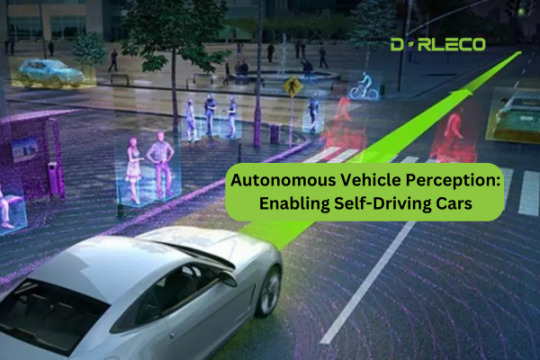
The development of Autonomous Vehicle Perception, popularly referred to as self-driving cars, has fundamentally altered both the automotive and transportation industries. These vehicles have the potential to reduce traffic, provide accessibility for people with disabilities, and improve traffic flow. One of the main tools autonomous cars use to navigate the complex network of roads and highways is its vision system.
Autonomous vehicles operate using autonomous vehicle perception. It comprises the ability of the car to sense and interpret its surroundings, analyze the information gleaned from several sensors, and make judgments based on this understanding. This introduction will address the key components and technologies of autonomous vehicle perception.
Sensors: Autonomous vehicles use a range of sensors to collect data about their environment. These sensors include cameras, radar, LiDAR (light detection and ranging), ultrasonic sensors, and inertial measurement units (IMUs). Every kind of sensor serves a particular purpose. LiDAR and radar, for instance, are needed for detecting objects and calculating distance, while cameras are needed for visual identification and IMUs are needed to track the motion of the vehicle.

Data Fusion: The noisy data produced by these sensors comes in a range of formats. The world surrounding the car is rendered coherent and cohesive by combining and processing this data using data fusion techniques. Sensor fusion techniques are critical to the construction of a trustworthy perception system.
Object identification and tracking: Neighboring objects need to be recognized and followed for an autonomous vehicle to navigate safely. This involves identifying traffic signals, road markers, other vehicles, and pedestrians. Sophisticated computer vision algorithms do these tasks, often using deep learning techniques such as recurrent neural networks (RNNs) and convolutional neural networks (CNNs).
Semantic Segmentation: To carry out semantic segmentation, autonomous cars need to be able to understand the semantics of their environment. Semantic segmentation is the process of giving each pixel in an image a category, such as obstacles, walkways, and streets. The car makes decisions about turning, changing lanes, and dodging hazards based on this information.
Mapping and Localization: Autonomous vehicles require high-definition maps and precise localization to determine their position on the road. Algorithms for simultaneous localization and mapping, or SLAM, help the car map its environment and find its location inside those maps.
Machine Learning and AI: The combination of artificial intelligence and machine learning. Autonomous vehicle sensing depends on machine learning. Large datasets are used to train deep learning models so they can better identify and understand complex scenarios encountered in the real world. These models evolve and improve over time with updates and real-world driving experience.
Benefits of Autonomous Vehicle Sensing: Making Self-Driving Automobiles
Possible Autonomous vehicles that can detect and understand their surroundings thanks to a range of advantages offered by autonomous vehicle perception have the potential to completely transform transportation and society. Some significant advantages of perception in autonomous cars are as follows:
Enhanced Safety: One of the primary benefits of autonomous vehicle perception is enhanced safety. A very accurate 360-degree view is provided by a variety of advanced sensors, including cameras, radar, lidar, and ultrasonic sensors, which continuously monitor the area surrounding the vehicle. Because of their wide awareness, autonomous cars can recognize and respond to possible threats, reducing the likelihood of accidents caused by human error like driving while intoxicated or preoccupied.
360-Degree Awareness: Perception systems in autonomous vehicles provide drivers with a comprehensive view of their environment, including any objects nearby and possible dangers. Self-driving cars can make informed decisions and safely navigate complex traffic conditions thanks to their ability to recognize stationary objects, cyclists, pedestrians, and other vehicles. Predictive analytics is a technique used by autonomous car perception systems to anticipate other drivers’ and objects’ movements. Because of its predictive capabilities, self-driving cars can react proactively to potential threats, improving driving safety and predictability.
Improved Decision-Making: Perception systems use machine learning algorithms to make driving decisions after evaluating vast volumes of sensor data. Because these decisions are based on real-time data, traffic laws, and preprogrammed objectives, the car can successfully negotiate complicated and dynamic situations. Autonomous cars can modify their driving technique based on their surroundings. For example, they may maintain safe following distances, slow down in crowded areas, and make snap decisions to avoid collisions, all of which contribute to making roadways safer.
Efficient Traffic Flow: Autonomous vehicles possessing perceptual abilities can communicate with traffic management systems and with one another. Faster travel times decreased traffic congestion, and improved traffic flow could all be outcomes of this communication.
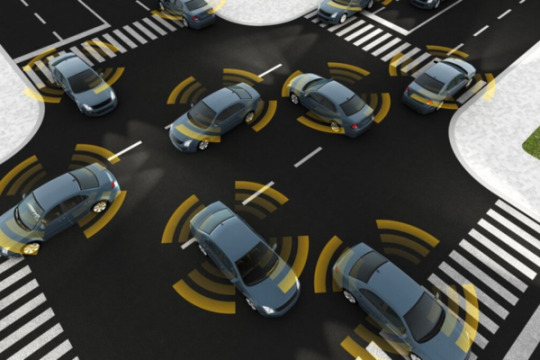
Decreased Fuel Consumption and Emissions: By adapting driving habits for optimal fuel efficiency, autonomous car perception systems can cut down on both fuel use and emissions. By making hybrid and electric car operations simpler, they can reduce the environmental impact of these vehicles.
Data Collection and Analysis: Information about traffic patterns, road conditions, and infrastructure needs can be gathered and transmitted by autonomous vehicles. This information can be used for traffic management, urban planning, and overall transportation system enhancement.
Autonomous Vehicle Perception’s Drawbacks: Making Self-Driving Cars Possible
Despite the many advantages of autonomous vehicles, several drawbacks and challenges need to be overcome before self-driving car technology can be successfully adopted. Some significant problems with autonomous vehicle perception are as follows:
Limitations on Sensors: Autonomous vehicles use a variety of sensors, such as lidar, radar, ultrasonic, and cameras, to sense their surroundings. Adverse weather conditions can affect these sensors and lower their accuracy and reliability. Examples of such conditions include continuous rain, snowfall, fog, or glare.
Cost of the sensor: High-quality sensors can be costly, especially lidar and high-resolution cameras. This cost could increase the total cost of autonomous vehicles and limit the availability of self-driving technology.
Maintenance of Sensors: To keep sensors operating correctly, they must be cleaned and maintained regularly. The buildup of dirt, grime, and debris on the surfaces of sensors can impair their functionality. Redundant sensors are critical to the safety of autonomous vehicles. If one sensor fails, the others ought to be able to make up for it. Assurance of redundancy can be costly and challenging.
Limited Perception Range: A vehicle’s capacity to recognize objects at a distance may be impacted by the limited range of some sensors, such as lidar. It can be challenging to adhere to this rule when driving on a highway or at high speeds.
Legal and Ethical Issues: It may be challenging to assign blame in incidents involving self-driving cars. Establishing moral standards for decision-making in dire situations is a never-ending task.
Human Interaction: To communicate with human drivers, pedestrians, and cyclists, autonomous vehicles must be able to effectively convey their awareness and intent. Ensuring seamless communication between human-driven and autonomous cars can present challenges.

Conclusion:
To sum up, autonomous vehicle perception is a revolutionary technology that serves as the basis for self-driving cars. It has enormous potential advantages but also poses several difficulties. Reduced traffic, more accessibility, cheaper operating costs, more safety, and environmental benefits are some of the benefits of autonomous vehicle perception. Furthermore, this technology has the power to revolutionize transportation networks and improve the practicality and efficiency of movement.
Adoption of autonomous vehicle perception is not without challenges and disadvantages, though. These include the price of technology, its limitations in inclement weather, technical difficulties, moral conundrums, worries about data security and privacy, loss of employment, legal and liability problems, and public reluctance to change.
Governments, businesses, and researchers must work together closely to fully realize the potential of autonomous vehicle perception and to overcome these obstacles. A smooth transition to autonomous vehicles will require significant investments in R&D, strict testing and validation procedures, the creation of precise rules and standards, and public education.
Future transportation systems could be safer, more effective, and easier to access because of the ongoing development of autonomous vehicle perception technology, even if there are still numerous challenges to overcome. These systems have the power to change how we move around and engage with our cities and roadways as they develop, ultimately providing a more promising and sustainable future for transportation.
#autonomousvehicle#simulation#testing#VCU#EVSoftwareservice#evCODE#ADASCode#VCUSupplier#VCUManufacturer
0 notes
Text
Machine Learning for Autonomous Vehicles
August 23, 2024
by dorleco
with no comment
Autonomous Vehicle Technology
Edit
Introduction
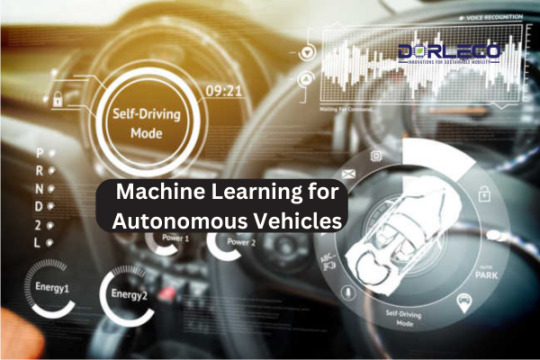
Machine learning has greatly aided in the creation and operation of autonomous vehicles (AVs). Machine Learning for Autonomous Vehicles, can navigate and make driving decisions on their own thanks to sensors, cameras, radar, and other technologies. The copious amounts of data generated by these sensors are processed by machine learning algorithms to guarantee the automobile is driven safely and effectively. This article provides an overview of how machine learning is being applied to autonomous vehicles.
1. Sensors and data collection
Autonomous vehicles are equipped with an array of sensors, ranging from LiDAR and radar to cameras and ultrasonic sensors.
These sensors gather information about the environment around the car, including the state of the roads, the presence of people and other vehicles, and traffic lights.
2. Information Gathering
Raw sensor data often contains noise and redundancy. Machine Learning for Autonomous Vehicles techniques are utilized for pre-processing and data cleaning.
Processes like data alignment, data filtering, and sensor fusion may be necessary when combining data from different sensors.
3. Observation
In perceptual tasks, machine learning models are used to understand the environment around the car.
Object detection and recognition algorithms Find and classify objects in the vicinity, such as other vehicles, pedestrians, and traffic signs.
To better comprehend the road scene, semantic segmentation categorizes each pixel in an image or point cloud.
4. Localization
The ability to accurately sense their direction and position is essential for autonomous vehicles.
When coupled with sensor data, machine learning can help in localization by employing techniques such as SLAM (Simultaneous Localization and Mapping).
5. Organizing and directing the course
Machine Learning for Autonomous Vehicles is used to design the vehicle’s path and motion.
Path planning algorithms let the car decide where to go and how to get there while avoiding obstacles and following traffic laws.
Control algorithms ensure that the car travels the intended route safely and effectively.
6. Learning via Reinforcement:
Reinforcement learning can be used to help autonomous cars learn from their interactions with their surroundings.
It can be applied to decision-making about complex and dynamic transportation situations.
7. AI and Human Interaction:

Machine learning models can also be used in autonomous vehicles to communicate with humans by understanding their requests and providing explanations for AI decisions.
8. Labelling and annotation of data:
Good quality labeled data is essential for training machine learning models in autonomous cars.
It is well known that the process of manually annotating certain objects and events in sensor data takes a lot of time and effort.
Benefits of Machine Learning for Driverless Cars
Machine Learning for Autonomous vehicles can boost the capabilities, productivity, and safety of autonomous vehicles (AVs), which is a major advantage. Using machine learning in autonomous cars has several advantages, some of which are listed below:
1. Improved Sensitivity and Object Recognition:
By processing large amounts of sensor data, machine learning algorithms can enhance autonomous vehicles (AVs) ability to detect and identify objects such as cars, pedestrians, and barriers.
These algorithms enhance the vehicle’s perception by adapting to various lighting and weather conditions.
2. Making choices quickly:
AVs can make real-time decisions based on their perception of the surroundings and historical data.
They may react quickly to unforeseen events like abrupt stops or the appearance of people.
3. Enhanced Security
Autonomous cars are equipped with machine learning technologies to foresee possible threats and take proactive measures to prevent crashes.
They can also continuously monitor their environment, which reduces the likelihood of driver tiredness and inattention.
4. Organizing a route effectively:
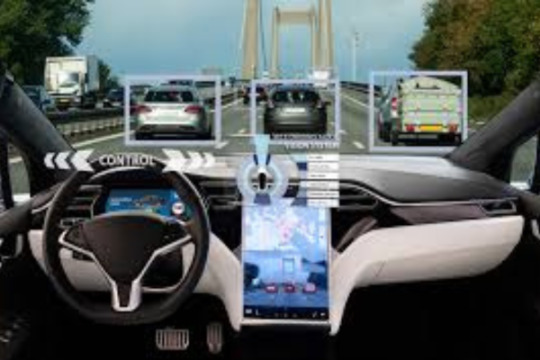
Machine learning-based path planning algorithms can optimize routes to save travel time, maximize fuel efficiency, and minimize vehicle wear and tear.
AVs can dynamically alter their routes in response to the flow of traffic.
5. Adaptive Education:
Thanks to Machine Learning Autonomous Vehicles (AVs) can adjust to and learn from their driving conditions. They may consistently improve their performance and decision-making by using real-world facts.
6. Diminished Human Error
Autonomous vehicles are not prone to human errors, such as distracted driving, weariness, or poor judgment — human errors that are a major cause of traffic accidents.
7. Traffic Control:
Machine learning can be used to optimize traffic flow by coordinating autonomous vehicles and improving general traffic management.
AVs can talk to each other and the traffic infrastructure to reduce congestion.
8. Decreased Emissions and Fuel Use:
Reduced fuel consumption and greenhouse gas emissions can be achieved through route optimization and efficient driving habits enabled by machine learning.
Drawbacks for Machine Learning for Autonomous Vehicles
While machine learning presents a plethora of benefits for autonomous vehicles (AVs), there exist many noteworthy drawbacks and obstacles linked to its implementation in this domain:
1. Safety Issues:
There are concerns regarding AV safety because ML models are erratic and prone to mistakes. A bad decision made by a machine learning algorithm could have disastrous consequences.
2. Absence of Common Sense
When driving, ML models may struggle to understand complex, unstructured situations due to their lack of common sense reasoning.
3. Diversity and Quality of Data:
Machine learning models require a wide variety of high-quality training data. Ensuring that data accurately represents all possible scenarios, including rare and edge occurrences, may prove to be challenging.
4. Costs of Data Annotation:
Labeling and annotating training data for ML models can be costly and time-consuming due to the vast amount of data required for AV development.
5. Data Privacy Issues:
The collection, keeping, and possible use of the vast amount of data that autonomous vehicles (AVs) gather from their environment raises privacy concerns.
6. Attacks by Adversaries:
Machine learning models in AVs can be impacted by adversarial attacks, which occur when malicious actors attempt to deceive or manipulate the algorithms by providing erroneous sensor data.
7. Insufficient Robustness

ML models might not perform well in unusual or unexpected situations that deviate from their training data because they might not generalize well.
8. Regulatory Obstacles:
The creation and application of machine learning-driven antivirus software requires the management of complex regulatory environments, some of which may not be fully amenable to this cutting-edge technology.
Conclusion:
To sum up, machine learning (ML) is a revolutionary technology that is essential to the creation and functioning of autonomous vehicles (AVs). There are many advantages and difficulties associated with its integration into the transportation industry.
It is critical to overcome these issues and ethically use machine learning’s benefits in autonomous vehicles as the industry develops. To guarantee that autonomous vehicles (AVs) develop into a secure, effective, and widely available form of transportation that benefits society at large, cooperation between industry players, regulators, researchers, and the general public is essential. The potential of machine learning in autonomous cars is still exciting, even with obstacles to be addressed. It can completely change the way we travel and improve traffic safety.
#machinelearning#autonomousvehicle#simulation#testing#VCU#EVSoftware#evCODE#ADASCode#VCUSupplier#VCUManufacturer
0 notes
Text
Autonomous Vehicle Simulation and Testing
August 22, 2024
by dorleco
with no comment
Autonomous Vehicle Technology
Edit
Introduction
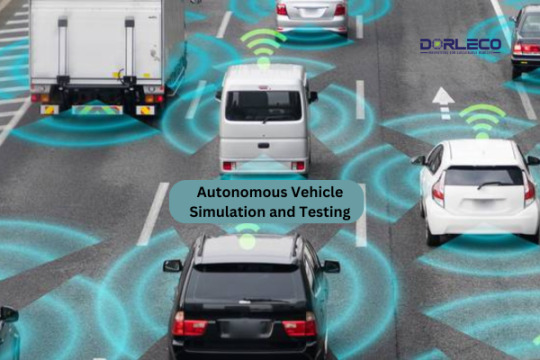
In the auto industry, autonomous vehicles — also referred to as self-driving cars — are a game-changer. These vehicles could increase transit’s efficiency, safety, and accessibility. Before being used on a large scale, they must first undergo extensive modeling and testing to ensure their dependability and safety. This introduction highlights the importance, key components, and challenges of autonomous vehicle simulation and testing while providing a broad overview of these processes.
1. The value of testing and simulating autonomous vehicles
Safety Assurance: Ensuring the safety of self-driving automobiles is essential. Testing and simulation provide a controlled environment in which possible system faults can be identified and fixed, averting mishaps and maintaining public trust.
Regulatory Compliance: Tight regulations apply to autonomous vehicles. Manufacturers can use autonomous vehicle simulation and testing to show that they meet these requirements.
Cost-Efficiency: Testing in actual environments can be expensive and time-consuming. Simulations enable cost-effective testing and rapid data collecting.
Performance Optimization: Through autonomous vehicle simulation and testing, autonomous vehicle systems can be tuned for optimal responsiveness, dependability, and performance.
2. Components of Autonomous Vehicle Testing and Simulation:
Sensor Simulation: LiDAR, radar, cameras, GPS, and other sensors are some of the many sensors that autonomous cars use. Simulations that mimic sensor inputs assess how the vehicle reacts to different circumstances.
Environment modeling: Virtual environments are created to replicate real-world events including traffic, pedestrians, and weather. This enables testing under numerous challenging conditions.
Behavioral Modelling: To evaluate a vehicle’s ability for safe navigation, simulation models its behavior, including course planning and collision avoidance.
Data Logging and Analysis: A lot of data is gathered during tests and simulations, and this data is analyzed to identify any issues, validate system functionality, and improve algorithms.
3. Types of Testing:

Hardware-in-the-loop (HIL) testing involves evaluating the autonomous vehicle’s hardware in a simulated environment, including its controllers and sensors. Consequently, it is possible to perform early validation without deploying the full vehicle.
Software-in-the-loop (SIL) testing: This type of testing involves running an autonomous vehicle’s software in a simulated environment. It assesses the vehicle’s decision-making procedures and algorithms.
Vehicle-in-the-loop (VIL): Using real cars, technology simulates traffic and surroundings. This tactic establishes a connection between simulation and real-world testing.
Real-World Testing: On closed tracks and open highways, real-world testing is done to confirm system performance when autonomous vehicle simulation and testing in safe situations are successful.
4. Difficulties:
Realism: Achieving a high degree of realism in simulations can be challenging. Realistic climatic conditions must be accurately reflected in simulation settings.
Diversity of Scenarios: It is imperative to test autonomous vehicles in a range of scenarios, including unusual and edge cases that can be difficult to fully recreate.
Regulatory Structure: Developing a clear legislative framework for autonomous vehicle testing and certification is a challenging and ever-changing process.
Cyber security: Security testing is a crucial phase in the development process because autonomous vehicles are vulnerable to hackers.
Benefits of Testing and Simulating Autonomous Vehicles
Autonomous Vehicle Simulation and Testing provide many benefits that make it possible to build and use self-driving cars. The following are some of the main benefits:
1. Improvement of Safety:
Autonomous Vehicle Simulation and Testing provide a secure and regulated environment for identifying and resolving possible security issues. This lowers the dangers associated with autonomous cars.
2. Lower Testing Expenses in the Real World:
Simulation testing is more cost-effective when compared to testing on real roads. When expenses for fuel, upkeep, and actual test tracks are removed, development becomes more efficient and less expensive.
3. Capability to Scale:
Through simulations, engineers may evaluate an autonomous vehicle’s performance in a range of conditions, facilitating rapid scaling and obviating the need for extensive real-world testing.
4. Repeatability of Scenarios:
Because they accurately replicate conditions and scenarios, simulated environments facilitate the comparison of results, validation of changes, and prediction of vehicle behavior in a variety of scenarios.
5. Fast Iteration
Simulation enables engineers to identify issues early on and take action to address them, leading to faster development of hardware and software.
6. Information Gathering and Evaluation:
Massive amounts of data from simulated testing are produced, enabling in-depth analysis and better understanding as well as performance adjustment of the self-driving car.
7. Security and Privacy:
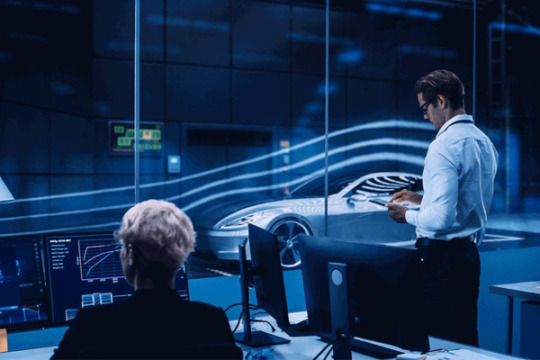
By preventing critical data or proprietary technologies from being exposed on public roadways, simulated testing reduces the risk of intellectual property theft and privacy concerns.
8. Flexibility:
Simulations can mimic a range of driving conditions, including extreme ones that are dangerous or challenging to duplicate in real-world testing, to perform an exhaustive analysis.
Drawbacks of Testing and Simulating Autonomous Vehicles
While there are numerous advantages to autonomous vehicle simulation and testing, these techniques also come with certain challenges. Some disadvantages of testing and modeling driverless vehicles are as follows:
1. Strict Realism
The intricacy of real environmental conditions may not always be correctly reflected in simulated environments, which could cause issues when assessing the performance of autonomous vehicles. Unrepresentative elements can include alterations in infrastructure, unmodeled road dangers, and unexpected behavior.
2. Excessive Fitting:
If autonomous systems have been predominantly optimized using simulation data, they may perform poorly when placed in unexpected real-world environments.
3. Realism of Sensors:
The subtleties of actual sensor inputs may not be fully reflected in simulated sensor data, which could lead to discrepancies in the system’s performance between simulation and real-world scenarios of human drivers.
4. Partial Coverage of Scenarios:
For simulations, creating an extensive scenario library can be a challenging and time-consuming task. It’s possible to overlook peculiar but significant events that are crucial to determining an autonomous vehicle’s level of safety.
5. Uncertainty in Simulations:
The modeling of the simulation environment may contain errors and uncertainties that compromise the validity of test results. Inadequate simulation testing could lead to a delusion of security.
6. Complexity of Hardware-in-the-Loop (HIL):

Because HIL simulations combine real hardware with virtual environments, they can be costly and challenging to set up and maintain. It could be challenging to synchronize and calibrate hardware components.
7. Needs for Data and Processing:
During simulation, enormous amounts of data are generated, and these quantities of data must be processed, stored, and analyzed — tasks that can be expensive and resource-intensive.
8. Dynamic Interactions with Traffic:
It can be challenging to mimic real-time interactions with other road users, including cyclists, pedestrians, and human drivers, because of their unpredictable nature and the need for high-fidelity modeling.
Conclusion:
To sum up, Autonomous Vehicle Simulation and Testing are essential steps in the creation and application of self-driving automobiles. These procedures are essential for improving the usefulness, safety, and dependability of autonomous systems. Although these approaches have advantages and disadvantages, taken as a whole, they have a largely favorable impact and will have a considerable influence on how transportation is developed in the future.
However, it’s crucial to recognize the difficulties and constraints associated with autonomous vehicle testing and simulation, like the requirement for accurate modeling, the possibility of overfitting, and the complexity of edge cases. Testing in the real world is still necessary to verify the technology in complicated and unpredictable environments.
Real-world testing and simulation must coexist for autonomous cars to meet the required safety and dependability requirements. Future transportation will be greatly impacted by the continuous development and integration of these techniques, which will open the door to safer, more effective, and more accessible autonomous vehicle simulation and testing.
Stay informed about our latest VCU products and autonomous vehicle simulation and testing services. For more information, contact us at [email protected] or visit our website at Dorleco-Home | Dorleco
#Chargingstations#autonomousvehicle#simulation#testing#VCU#EVSoftware#evCODE#ADASCode#VCUSupplier#VCUManufacturer
0 notes
Text
VCU software flash and calibration
August 20, 2024
by dorleco
with no comment
Autonomous Vehicle Technology
Edit
Introduction

The engine’s operational software and specifications must usually be updated to flash and calibrate a VCU. To achieve performance optimization, emissions compliance, and other goals, the automotive industry widely employs this procedure. The procedures needed for VCU software flash and calibration are summarized as follows:
1. VCU Interface Access
To connect to the VCU, use a diagnostic or flashing tool that is compatible with it. These instruments may come with hardware interfaces like OBD-II connectors or particular cables.
2. Backup of original software:
Before making any changes, you must create a backup copy of the original VCU program. This allows you to return to the initial configurations if necessary.
3. Select the calibration for VCU Software:

Use calibrating software that is specifically made to work with VCU. With the help of this software, you may change fuel injection timing, ignition timing, air-fuel ratios, and other performance-related parameters.
4. File for Load Calibration:
The program has to be updated with the VCU software flash and calibration file. This file contains the modified parameters and settings that you want to program into the VCU.
5. Adjust the Parameters:
To get the appropriate performance characteristics, make the necessary adjustments to the settings. This could entail boosting horsepower, maximizing fuel economy, or adhering to particular pollution regulations.
6. Confirm the Modifications:
Check and validate the adjustments you made to the calibration file. Verify that the changes are in keeping with the intended goals and remain within the engine components’ safe operating limitations.
7. Flash ECU:
Once you are satisfied with the calibration settings, use the flashing tool to write the new calibration for VCU. The original program is replaced with the new software in this way.
8. Conduct Examinations:
After flashing the VCU, conduct thorough testing to ensure the engine operates as it should. This can involve testing the vehicle on the road, running it through its paces on a dynamometer, and using diagnostic tools to track data in real-time.
9. Optional Fine-Tuning:
Make any necessary calibration modifications based on the test results. Further adjustments may be made to improve performance, fuel efficiency, or other aspects during this iterative stage.
Benefits of VCU software flash and calibration

VCU software flash and calibration have numerous advantages, particularly in terms of enhancing and perfecting vehicle performance. These are a handful of the principal benefits:
1. Improved Results:
VCU software flash and calibration can be used to change engine parameters, such as fuel injection timing, air-fuel ratios, and ignition timing. This could lead to better engine performance, such as increased horsepower, torque, and overall driveability.
2. Better Fuel Efficiency
By optimizing fuel delivery and combustion, calibration can raise fuel efficiency. This is highly advantageous for drivers who want to use less gasoline and attain higher miles per gallon (MPG).
3. Personalization & Customization:
Enthusiasts and master tuners can change the VCU settings to suit different preferences or driving styles. This degree of customization will be especially appealing to those looking for a unique and personalized driving experience.
4. Adjusting to Aftermarket Adjustments:
When performance or aftermarket parts are added to the car, calibration ensures that the VCU adapts to the modifications. This helps maintain the highest level of engine performance and dependability.
5. Enhanced Power Distribution:
By producing a more responsive and smoother throttle response, VCU software flash and calibration can improve power delivery across the RPM range. Both regular driving and high-performance applications benefit from this.
6. Adherence to Emission Guidelines:
It is possible to calibrate the vehicle to ensure that it satisfies emissions standards going forward. This is important since it allows you to enjoy improved performance while still following environmental regulations.
7. Ability to Diagnose:
Advanced calibration systems often feature diagnostic functions that allow tuners to watch and diagnose the engine in real time. This can help ensure that the engine operates within safe parameters and aid in troubleshooting.
8. Data Evaluation and Recording:
Many calibration tools include data-logging capabilities that let tuners record and analyze various engine parameters while the engine is operating. This data can be utilized to further refine the calibration for optimal performance.
9. Updates swiftly and can be undone:
VCU software flash and calibration, and the process is often reversible. This suggests that if issues arise or the user wants to return to the factory settings, they may easily flash the original software back onto the VCU.
10. Adaptive Education:
Adaptive learning is a feature of a few modern VCUs. calibration for VCU allows for performance enhancement based on actual driving conditions by making adjustments that the VCU may progressively learn and adapt to.
The drawbacks of VCU software flash and calibration
While VCU software flash and calibration offer numerous advantages, there may also be risks and disadvantages. It’s critical to understand the following aspects before deciding to modify the VCU:
1. Warranties that lapse:
Modifications to the VCU software may result in the loss of the vehicle’s warranty. Manufacturers frequently warn that any modifications to the original hardware or software may render the warranty null and void.
2. Emissions Compliance:
VCU software changes may have an impact on emissions, which could cause the vehicle to fail emissions testing or violate the law. This could have legal ramifications and affect the vehicle’s roadworthiness in some places.
3. Damage to the Engine:
Inadequate calibration or extreme tuning can cause damage to an engine. For example, operating an engine at the incorrect ignition timing or with an extremely lean air-fuel mixture can result in overheating, piston damage, and other issues.
4. Issues related to driveability:
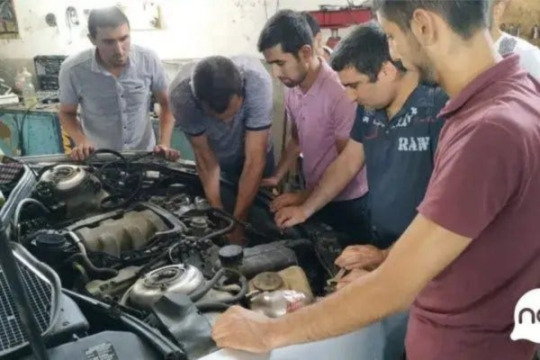
A badly tuned VCU may be the source of driveability issues such as harsh idling, stalling, or resistance during acceleration. This could put the dependability of the vehicle and the driving experience as a whole in danger.
5. Legal and Regulatory Concerns:
It may be illegal in some places to alter the VCU. For example, tampering with pollution control systems could lead to fines and penalties.
6. Dependency on Tuner Knowledge:
The VCU’s tuning performance is mostly dependent on the skills and expertise of the tuner. Incompetent or unskilled tuners could inadvertently create problems or fail to achieve optimal performance.
7. The cost of professional tuning:
Professional tuning services can be expensive, and the investment might not always be worthwhile. It might also require multiple tuning sessions to get optimal performance, increasing the overall cost.
Conclusion:
When using VCU software flash and calibration, there are a few things to remember to maximize vehicle performance. It is important to consider the potential benefits of VCU tuning about the risks and difficulties involved.
In light of these factors, anyone considering VCU tuning should proceed with caution, ensure that all legal requirements are satisfied, and, if needed, seek the assistance of reputable professionals. Ultimately, a well-informed and cautious approach to VCU tuning can result in a well-balanced enhancement to the vehicle’s driveability and performance.
Discover more about our newly launched VCU products and EV software services. Reach out to us at [email protected].
0 notes
Text
Integration of ADAS features into VCUs
August 15, 2024
by dorleco
with no comment
Autonomous Vehicle Technology
Edit
Introduction

To enhance the safety, automation, and overall performance of the vehicle, Advanced Driver Assistance Systems (ADAS) capabilities must be integrated into Vehicle Control Units (VCUs) through a complicated procedure that includes adding hardware and software components. Integrating ADAS features into VCUs usually includes adaptive cruise control, lane departure warning, computerized emergency braking, and other technologies.
The following are the main considerations and actions for adding ADAS functionality to VCUs:
1. Analysis of Requirements:
Clearly state the Integration of ADAS features into VCUs you wish to incorporate into the vehicle. Determine which crucial actuators, sensors, and communication interfaces are needed for each feature.
2. Integration of Sensors:
Incorporate sensors to collect data about the environment around the vehicle, such as lidar, radar, cameras, and ultrasonic sensors. Make sure the sensors are calibrated and synchronized correctly for the right information.
3. Fusion of Data:
Use information fusion techniques to bring together data from exceptional sensors.
This enhances the precision and dependability of the statistics that the ADAS algorithms rely on.
4. Development of Algorithms:
Create or implement ADAS algorithms to perform tasks such as lane-keeping assistance, collision avoidance, adaptive cruise control, and more. These algorithms can be used in a VCU-based software application.
Learn More about VCUs, or vehicle control units
5. Hardware Context:
Choose or design a VCU that meets the computing needs of the ADAS algorithms.
Take into account strength intake, thermal control, and physical space limits when integrating the VCU into the car’s architecture.
6. Interfaces for Communication:
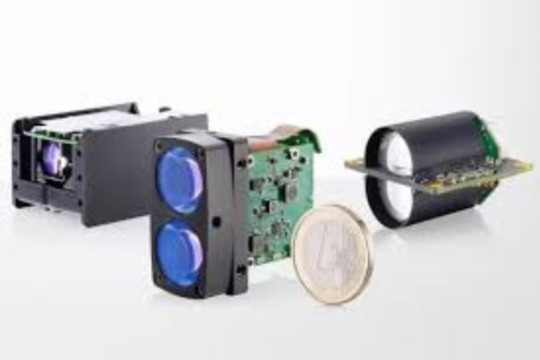
Create interfaces for communication between the vehicle control unit (VCU) and other automotive systems, such as the body control module (BCM), transmission control unit (TCU), and engine control unit (ECU).
Make sure the VCU can communicate real-time information with other ECUs.
7. Integration of Software:
Connect the VCU firmware to the ADAS software program.
Create or control the operating system and middleware to support ADAS features.
8. Validation and Testing:
Examine the integrated device in depth in both controlled settings and real-world scenarios.
Verify each ADAS function’s overall effectiveness from my perspective and as a component of the overall system.
9. Regulatory Compliance:
Verify that the Integration of ADAS features into VCUs abides by all relevant safety guidelines and requirements.
Obtain the necessary system certifications.
10. Updates via Over-the-Air (OTA):
Create OTA update processes to ensure that the most recent features and virus fixes are added to the ADAS software.
Advantages of ADAS Features Integrated Into VCUs
Advanced car safety, comfort, and universal use are all benefited from the incorporation of Advanced Driver Assistance Systems (ADAS) elements into Vehicle Control Units (VCUs). Here are a few major benefits:
1. Increased Security:
By assisting drivers in preventing serious injuries, advanced driver assistance systems (ADAS) such as automated emergency braking, lane departure warning, and collision warning contribute to universal vehicle protection.
Adaptive cruise control and other similar systems maintain a safe following distance, reducing the risk of rear-end crashes.
2. Decreased crashes and accidents:
The probability of accidents and injuries can be reduced by using ADAS features, which can identify and respond to capacity threats more quickly than a human motive force.
Emergency braking systems can operate quickly to stop or lessen the effects of an accident.
3. Enhanced Support for Drivers:
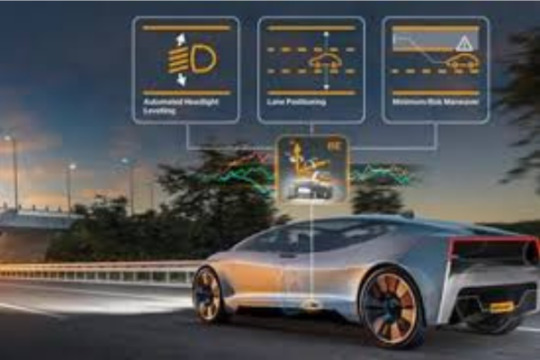
Providing automated assistance, adaptive cruise control devices and lane-maintenance assistance makes lengthy rides more comfortable.
4. Enhanced Fuel Economy:
Adaptive cruise control is one of the ADAS technologies that can improve an automobile’s acceleration and velocity, mostly to increase gas efficiency.
5. Optimization of Traffic Flow:
By controlling the speed and gap between cars, ADAS structures can help improve site visitors who follow the flow.
Motors can communicate with one another through cooperative adaptive cruise control, which maximizes travellers’ ability to follow the traffic on highways.
6. Help with Parking:
Computerized parking assistance systems, one example of an ADAS feature, assist drivers in parking more accurately and reduce the risk of accidents related to parking.
7. Enhanced Usability
The ADAS technology enhances the riding experience for individuals with disabilities or those who may experience difficulties when utilizing it.
Some features, like parking assistance and automated braking, may make the car more accessible to a wider group of people.
8. Preventing Collisions:
Forward collision warning and avoidance systems are examples of ADAS features that assist drivers in avoiding possible collisions by providing timely alerts and, in some situations, implementing corrective action.
9. Benefits of Insurance:
Some insurance providers offer discounts for cars with contemporary safety features like ADAS technology. These reductions may be justified by a decreased chance of accidents.
10. Innovation and Competitiveness in Technology:
When the Integration of ADAS features into VCUs, an automobile’s technological profile is improved and its competitiveness in the market is increased.
Vehicles with cutting-edge protective features are frequently sought after by consumers, which affects their decision to purchase.
11. Adherence to Regulations:
Certain jurisdictions have begun requiring specific ADAS characteristics as modern motor systems to increase overall road safety. Adherence to evolving policies is guaranteed by including such characteristics.
12. Competitiveness and Technological Innovation:
An automobile’s technological profile is improved and its competitiveness in the market is increased by the integration of ADAS functions. Customers frequently look for cars with cutting-edge security features, which affects the decisions they make when making a purchase.
13. Observance of Regulations:
Several jurisdictions have started requiring certain ADAS features, such as sophisticated motor systems, to improve overall road safety. By integrating those features, you can make sure that changing policies are followed.
14. Be Ready for Self-Driving Vehicles:
Advanced autonomous riding capabilities are constructed using ADAS capabilities as the foundation. The basis for upcoming self-sustaining vehicle advancements is laid by integrating those features into VCUs.
Consequences of Including ADAS Features in VCUs
Although there are many advantages to integrating Advanced Driver Assistance Systems (ADAS) elements into Vehicle Control Units (VCUs), there are certain disadvantages and difficulties as well. To guarantee the safe and efficient implementation of ADAS systems, it is critical to solve these concerns. Here are a few disadvantages:
1. Expense of Implementation:
The inclusion of sensors, actuators, and complex software is required for the integration of ADAS capabilities, which raises the vehicle’s total cost.
2. Costs of upkeep and repairs:
The upkeep and repairs of ADAS components could be complex, and their replacement can be costly. Owners may have to pay more for repairs as a result.
3. Complexity and Trustworthiness:
The overall complexity of the vehicle grows with the addition of sophisticated ADAS systems. This intricacy may result in possible dependability problems as well as difficulties in problem diagnosis and resolution.
4. Calibration Difficulties:
Accurate operation of ADAS sensors depends on proper calibration. Any misalignment or improper calibration can cause erroneous readings and jeopardize the safety features’ efficacy.
5. Excessive dependence on technology by drivers
Over-reliance on the Integration of ADAS features into VCUs might cause drivers to lose concentration on the road and become complacent. This is the phenomenon known as “automation complacency”.
6. Restricted Applicability in Specific Situations:
When sensors are blocked or exposed to extreme weather (such as heavy rain, snow, or fog), ADAS components may not function as well as they could.
7. Privacy and data security issues:
Much data is gathered and processed by ADAS systems. If this data is susceptible to hackers or unauthorized access, worries about its security and privacy may surface.
8. Concerns about Interoperability and Standardization:
Interoperability problems could arise if different car manufacturers don’t adhere to the same standards. This could make it more difficult for maintenance and repair facilities and restrict the supply of ADAS components made by other companies.
9. Erroneous Alerts and Diversions:
False alarms may be generated by ADAS systems, giving the driver needless warnings. Drivers who experience false alarms frequently may become irritated and distracted.
10. Drivers’ Adaptation Period:
It could take some time for drivers to become accustomed to the new technology and discover how to utilize ADAS features. These safety mechanisms may be misused or underutilized as a result of ignorance and ignorance.
11. Regulatory Compliance Difficulties:
It can be difficult to comply with changing legal requirements for the Integration of ADAS features into VCUs, particularly when standards are always changing. Manufacturers have to keep up with changes and make sure local safety regulations are followed.
12. Restricted Independence and Human-Machine Communication:

Conclusion:
The incorporation of Advanced Driver Assistance Systems (ADAS) functionalities into Vehicle Control Units (VCUs) signifies a significant advancement in automobile technology, offering numerous benefits and posing challenges as well.
In conclusion, addressing the associated challenges is essential to ensure a harmonious integration that benefits every driver and the automotive industry as a whole, even as the integration of ADAS capabilities into VCUs brings about a transformative shift in vehicle safety and comfort. The ADAS era’s future will be significantly shaped by ongoing innovation, regulatory cooperation, and consumer education.
Examine how ADAS features can be integrated into VCUs. To find out more about our cutting-edge VCUs and the interesting Ev software services we provide, visit our website. connect with us at [email protected]
0 notes
Text
Vehicle Diagnostics and Communication
August 14, 2024
by dorleco
with no comment
Autonomous Vehicle Technology
Edit
Introduction
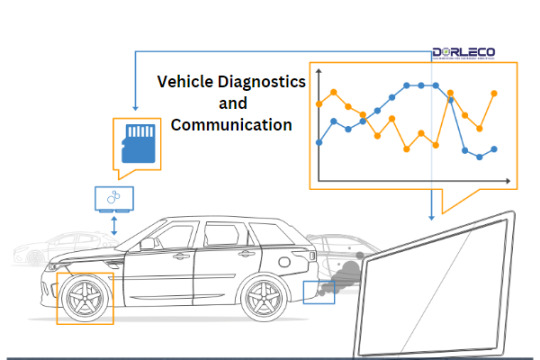
Vehicle communication and diagnostics are an integral part of modern car technology and are necessary for maintenance, performance tracking, and troubleshooting. These systems have significantly evolved with the creation of electronic control systems and the integration of cutting-edge technology into cars. Important aspects of automotive communication and diagnostics include the following:
1. On-board Diagnostics, or OBD:
OBD (On-Board Diagnostic): OBD is a standardized system that keeps track of an automobile’s engine and other vital systems. It comes in two versions: I and II. Introduced in the 1980s, OBD-I, or the first generation, was replaced as the industry standard by OBD-II, or the second generation, in the mid-1990s. OBD-II is more extensive since it uses standardized diagnostic connectors and codes.
2. Troubleshooting Diagnostic Codes (DTCs):
Codes for errors: When a fault is detected by an automobile’s onboard computer, a Diagnostic Trouble Code (DTC) is generated. These codes provide professionals with details about the specific scenario, allowing them to locate and resolve problems quickly.
3. Protocols for Communication:

In modern cars, the Controller Area Network, or CAN bus, is a commonly used communication protocol that allows various electronic control units (ECUs) to communicate with one another. It enables efficient communication and data sharing in real-time amongst different car systems.
4. Diagnostic Tools & Scan Tools:
OBD-II Scanners: Mechanics and auto owners use OBD-II scanners to extract DTCs, monitor live data, and execute various diagnostic procedures. To get data from the internal computer, these devices connect to the OBD-II port on the vehicle.
5. Remote diagnostics and telematics:
Telematics Systems: Many modern cars are equipped with telematics systems that allow for remote diagnosis and monitoring. The capacity of these systems to relay data to a central computer allows for real-time research of the health, performance, and maintenance needs of vehicles.
6. Manufacturer-Specific Diagnostics:
Manufacturer-only Systems: Certain manufacturers have proprietary diagnostic systems that might be able to meet or exceed OBD-II standards. It is often necessary to use specific hardware and software to perform extensive diagnostics on these systems.
7. Wireless Transmission:
Bluetooth and Wi-Fi: Wireless technologies like Bluetooth or Wi-Fi are used by certain diagnostic devices to link to an automobile’s onboard computer. As a result, doing diagnostics is now more versatile and convenient.
8. Advanced Driver Assistance (ADAS) Systems:
Sensor Diagnostics: Modern cars with advanced driver assistance systems (ADAS) use cameras and sensors to perform tasks like lane deviation warning and automated emergency braking. To guarantee optimal functioning, these sensors must be calibrated and monitored as part of the diagnostic processes for these systems.
9. Security online:
Security Issues: With automobiles becoming more networked, cybersecurity is becoming more important. Ensuring the security of automobile communication systems is crucial to prevent unauthorized access and potential cyber threats.
Advantages of Diagnostics and Vehicle Communication
Vehicle diagnostics and communication can benefit auto owners and mechanics in several ways. Here are a few key advantages:
1. Early Problem Identification
Vehicle communication and diagnostics enable the early detection of potential issues with the vehicle’s systems. By doing this, maintenance becomes proactive, and minor problems are prevented from becoming bigger, more costly ones.
2. Less Downtime
Quick and accurate diagnostics can reduce the time a vehicle takes without power. When problems are found and resolved quickly, vehicles spend less time off the road, which improves operational efficiency, especially in commercial fleets.
3. Cost-cutting Measures:
Finding and fixing issues early on may result in cost savings. If automobile owners address problems before they get worse, they can save spending a lot of money on repairs and replacements. Regular diagnostics can also lower operating costs by increasing fuel efficiency.
4. Increased Productivity:
Performance is increased by using diagnostics to ensure that every system in the vehicle is operating as effectively as possible. This includes engine efficiency, emission management, and general vehicle dynamics. More fuel efficiency and a more comfortable ride are two benefits of improved performance.
5. Emissions Management and Ecological Effects:
Enhanced diagnostics lead to better emission control. Verifying that the vehicle’s emission control systems are functioning properly helps to reduce harmful emissions, which is good for the environment, and to ensure that emission regulations are followed.
6. Telematics and remote monitoring:
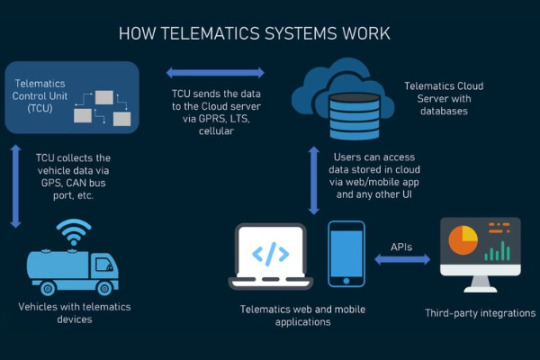
The performance and health of a vehicle can be remotely monitored thanks to telematics technology. They are commonly connected to diagnostics and vehicle communication. This is especially helpful for fleet management because it lets managers keep an eye on the condition of multiple vehicles without physically inspecting them all.
7. Making Decisions Based on Data:
Vehicle diagnostics and communication give a wealth of data that can be analyzed to aid in decision-making. Fleet managers, mechanics, and automobile owners can utilize this information to create maintenance schedules, map out the best routes, and make strategic decisions about their fleet of vehicles.
8. Contentment with Customers:
The ability of service staff to accurately and quickly diagnose and resolve issues affects customer satisfaction. Vehicle owners place a high value on timely and efficient maintenance, and better diagnostics can enhance the whole experience for customers.
Diagnostics and Vehicle Communication’s Drawbacks
Vehicle communication and diagnostics have many benefits, but they also have some drawbacks and challenges.
1. Technical expertise and complexity:
Advanced diagnostics systems may require specific technical knowledge to diagnose and fix issues. This complexity could be difficult for individuals without the necessary knowledge or abilities, leaving them dependent on skilled mechanics or technicians.
2. Equipment and Training Costs:
Acquiring high-quality diagnostic equipment can be expensive, and training employees on how to use and interpret the equipment appropriately also adds to the costs. For individual vehicle owners or smaller auto repair shops, this might be a significant expense.
3. Compatibility Problems:
Compatibility problems might arise, especially in older cars or with aftermarket items. Some diagnostic methods and tools may not be completely compatible with every make and model, which may limit their applicability in specific situations.
4. Cybersecurity Risks:
Risks related to cybersecurity are probably going to rise as cars get more and more networked. Vulnerabilities in communication systems could be exploited by hackers, putting vehicle safety and data security at risk. To protect automotive communication systems, manufacturers need to implement robust cybersecurity measures.
5. Excessive Dependence on Technology:
An over-reliance on diagnostic tools could lead to a loss of interest in traditional troubleshooting methods. When technicians rely too heavily on automatic diagnostic results, they run the danger of overlooking less common or complex issues that require a deeper understanding of vehicle systems.
6. Privacy Issues:

Telematics systems raise privacy concerns since they are often integrated with vehicle diagnostics and communication. Regularly monitoring an automobile’s location and performance could be perceived as a privacy infringement; thus, laws and transparent channels of communication are required to alleviate these concerns.
7. Limited Capacity for Self-Help:
Even though many consumers may purchase OBD-II scanners, more advanced diagnostics typically require specific hardware and software. This increases the difficulty level for car owners to perform various diagnostic procedures themselves, hence increasing their reliance on professional services.
8. Rapid obsolescence of technology:
New technologies are being introduced regularly, and the automobile industry is changing quickly. The rapid pace of development can lead to the obsolescence of diagnostic equipment, posing a challenge for professionals and repair shops to remain current with the latest techniques and tools.
Conclusion:
To sum up, car diagnostics and communication are essential parts of contemporary automobile technology, offering a host of advantages as well as some drawbacks. The progression of OBD-II systems from basic to sophisticated, along with telematics and remote monitoring features, has completely changed the way cars are serviced and maintained. Early problem identification, less downtime, financial savings, optimal performance, and increased safety are among the benefits. These technologies guarantee regulatory compliance, improve consumer satisfaction, and enable data-driven decision-making.
Ongoing industry attention is necessary, nevertheless, because of obstacles including the complexity of diagnostic systems, the accompanying costs of training and equipment, compatibility problems, and cybersecurity dangers. The dynamic nature of this sector is further highlighted by privacy concerns, restricted do-it-yourself skills for sophisticated diagnostics, and the potential for quick technical obsolescence.
It will be essential to solve these issues through standardization, enhanced cybersecurity protocols, and easily available training as the automotive industry innovates more. A more effective, secure, and long-lasting automotive ecosystem will result from finding a balance between maximizing the benefits of car communication and diagnostics and minimizing any potential downsides. Future developments should bring about cars that are connected, maintained, and able to adapt to changing consumer demands as well as those of the automotive industry at large.
Check for our exciting list of (Vehicle Control Units) VCUs and the useful system Engineering services we provide. connect with us at [email protected]
#EVSoftwareserviceprovider#vehiclecommunication#vehiclecontrolunit#VCU#EVSoftware#evCODE#ADASCode#VCUSupplier#VCUManufacturer
0 notes
Text
Things to know about Vehicle-to-Grid technology (V2G)
August 13, 2024
by dorleco
with no comment
Others
Edit
Introduction

You may be surprised to learn that electric cars (EVs) provide advantages for the environment and their drivers even when they are not in use. The development of vehicle-to-grid technology is to blame for this.
V2G technology is a component of the larger endeavor to attain a future free of carbon emissions. The disadvantage of many renewable energy sources is that the energy they generate must be used right away or stored. Through the ability to mix more renewable energy into our energy infrastructure, V2G mitigates the effects of climate change.
Stationary energy storage, or large power banks, is gaining popularity. They are a great way to store the energy generated by large solar power facilities. It’s also common to see pump stations, where water is pumped up and down to store energy. EV batteries are regarded as the most cost-effective form of energy storage as they don’t require any extra gear.
Ten things about V2G that you should know are as follows:
1. What is the nature of V2G technology?
Extra energy from an EV battery is supplied to the national grid via vehicle-to-grid technology. In addition to potentially helping to increase grid supply during times of high demand, V2G can also bring in money for EV owners.
DC smart chargers designed specifically for two-way transmission are a need for owners of electric vehicles. To avoid using the vehicle’s unidirectional onboard charger, they can either use the grid to charge their car or sell the electrical energy they have stored back to the grid. At predetermined intervals that are most effective for the owner and the grid, the charger decides when to import and export electricity from the EV.
For charging at home or work, the maximum V2G charging power of around 10 kW is adequate. In the future, there will be more comprehensive charging choices.
2. What does “grid balancing” mean?

System balancing makes sure that there is power available from the power system when it is needed. When the grid is unbalanced, utilities must purchase electricity on the open market or suffer power disruptions.
In a traditional grid balancing scenario, power plants with a high fossil fuel dependency are used more frequently. As a result, fuel consumption and emissions increase. Using battery energy is a far better choice when it comes to costs and environmental impact.
Increased frequency of surges, shortages, brownouts, and blackouts in America’s electrical infrastructure is expected to continue due to EV charging, among other reasons. By 2030, there will be up to 35 million EVs in the US. That represents a large demand on the electrical grid as well as a substantial battery power requirement that may be met by lowering the frequency of blackouts and brownouts on the system.
3. How does V2G function?
When it comes to driving, owners of electric vehicles (EVs) want to have enough energy in their car batteries; nevertheless, the average car is parked around 90% of the time. V2G efficiently utilizes the lost power.
When an EV is parked, its owner can participate in grid balancing by leaving it connected to a V2G-capable smart charger. Their EV may recharge at home overnight, when prices are often at their lowest, and sell electricity to the grid while parked at work during peak demand hours.
4. What Varieties of V2G Exist?
There are three different varieties of Vehicle-to-Grid technology: unidirectional, bidirectional, and bidirectional local.
In unidirectional V2G (also known as V1G), there is only one energy flow: from the grid to your electric car. You can only replace your battery when renewable energy power plants are producing more electricity than they need to. Using EVs increases energy stability and balances the frequency of the grid.
The local energy needs of your house or place of business can only be met by bidirectional local V2G. Vehicle-to-home (V2H) and vehicle-to-building (V2B) are the two categories of bidirectional local V2G.
Most people refer to bidirectional Vehicle-to-Grid technology, which covers the entire grid when they discuss V2G technology. With this kind, energy is stored in your EV battery and used when needed.
5. What are the primary benefits of V2G?
The EV market could be greatly impacted by V2G in several ways.
Reduces grid stress and improves grid stability. Cuts carbon emissions by producing clean, green energy. Helps EV owners drive more affordably and effectively sell excess energy to provide EV owners with more benefits.
Reduces the total cost of ownership for the fleet
Reducing dependency on fossil fuels can be accelerated by using vehicle-to-grid (V2G) technology to create a cleaner, smarter, more resilient, and flexible grid.
6. Does V2G affect car battery life?

V2G technology’s detractors assert that it shortens the life of EV batteries. The majority of specialists think that the occasional V2G discharge does not affect battery life. Nevertheless, researchers are always looking at how V2G affects the longevity of EV batteries.
7. What does it mean to integrate a car with the grid?
Vehicle-to-grid integration, or VGI, is a concept that builds upon vehicle-to-grid technology. The National Renewable Energy Laboratory (NREL) is developing and accessing fully integrated systems that connect EVs, behind-the-meter storage options, buildings, power grids, charging infrastructure, and renewable energy sources.
8. How much does V2G cost?
It’s predicted that the price of the car will increase by $200 to $400 with V2G functionality. The additional $4,500–$5,500 for a 10-kW (Level 2) DC bi-directional EVSE unit is the responsibility of the commercial charging station (or, in the case of private chargers, the individual EV owner or business).
9. V2X: What is it?
Utilizing V2X, a bidirectional charging technique, you can power any device or product using the batteries in your car. An electric vehicle (EV) may power a house for up to three days straight if it uses less energy than the average American household, which uses less than 30 kWh daily.
10. How Is the Grid Connected to Vehicles Through Technology?
With the use of Vehicle-to-Grid technology, EVs may communicate with the grid and either release extra energy back into the system or demand power for charging. When demand is strong, these vehicles can provide stored energy, acting as a decentralized power source. However, they only charge at off-peak hours when there is an excess of electricity. V2G, which enables an electric automobile to connect to the electrical grid and add power via a particular bidirectional charger, requires smart technology. With built-in power converters, these state-of-the-art devices can be configured to either recharge the electric vehicle’s battery or return power to the grid.
Utilizing V2G Technology Applications:
1) Electric Vehicle Fleet Management: To efficiently manage their EV fleets, businesses can utilize V2G to schedule charging and discharging, reduce operating expenses, and support environmental initiatives.
2) Grid Ancillary Services: V2G technology makes it easier to provide grid ancillary services including voltage control, reactive power support, and enhanced grid stability.
3) Integration of smart homes: V2G-equipped EVs can power homes during peak hours, cutting down on electricity costs and enabling easier energy management at home.
4) Intelligent Energy Trading: Vehicle-to-grid technology fosters a thriving energy exchange market by facilitating energy trading between EVs and other EVs or the grid.
11. How Can V2G Encourage the Uptake of EVs?

Developing clear rules and gaining regulatory approval are necessary to make V2G technology widely available. These initiatives provide compatibility between different cars and charging infrastructure and promote V2G integration by defining price structures and constraints on grid access. Thanks to the increased availability of V2G-capable charging infrastructure in residences, workplaces, and public areas, participating in V2G is now easier for EV owners. Collaboration among stakeholders advances technology, and large-scale demonstration projects highlight the benefits of V2G, encouraging its broader usage. To ensure grid stability, enhance energy management, and perfect V2G technology for widespread use, more research and development is still required.
12. Is It Possible to Connect Cars to India’s Grid?
India’s power grid is mostly dependent on V2G. India is expected to create 500 GW of renewable energy by 2030, and during that time, around 40% of newly sold automobiles in the country are expected to be electric. It’s interesting to note that over 75% of two- and three-wheeler markets may embrace electric vehicles, highlighting the enormous potential for EV batteries to promote V2G technology across India’s energy sector.
India is a country that could use Vehicle-to-Grid technology, but there are a few major reasons why it isn’t ready yet. The EV infrastructure is starting to take shape, but quicker deployment is needed because V2G requires bi-directional chargers, which are now lacking. Rules that specify grid access and promote user involvement need to be compliant with V2G integration. Strengthening the grid infrastructure becomes essential, necessitating changes to regulate the flow of electricity in both directions. More people must become aware of the benefits of V2G, highlighting its role in sustainability and grid support. To effectively implement V2G in India, several large-scale projects are needed, including infrastructure construction, legislative clarification, grid upgrades, and awareness campaigns.
13. Opportunities and Challenges
Due to their built-in battery storage capacity, electric vehicles (EVs) present an attractive and flexible choice for the power grid because they spend a significant portion of their lifetimes parked. This unique feature generates the massive storage capacity of the EV fleets. These EVs act as variable loads and distributed storage resources to support power system operations. V2G can optimize the synergies between EVs and renewable energy sources and lessen the effect of extra load on the power system when combined with renewable energy sources. V2G is therefore particularly crucial for solar-powered systems. Carbon-intensive fossil fuel facilities are utilized less frequently to balance renewable energy sources by utilizing smart EV charging. When V2G is deployed, distribution grid investments might not be required.
A few challenges need to be addressed before India can fully grasp the promise of V2G. Since it is anticipated that the adoption of EVs will accelerate in smaller car segments, a larger number of EVs would be needed to build a storage network. A gadget connecting these little cars, or even just the batteries inside, might unlock enormous potential. Another challenge is creating bidirectional charging stations, which enable the network of batteries to serve as an energy storage system. Not with this vital support system.
Electric cars (EVs) can only use energy; they cannot put energy back into the system. India needs to seize the opportunity provided by V2G, which provides a solution for zero carbon emissions in energy and mobility if it is to reach its targets for 2030 and beyond.
Conclusion
Vehicle-to-grid technology allows electric vehicles to link to energy grids innovatively, offering enhanced grid stability and sustainability. Even though India seems ready for V2G integration, this innovation needs to be advanced in the direction of a sustainable energy future by removing physical barriers and promoting regulatory consistency.
#EVSoftwareserviceprovider#vehiclecommunication#vehiclecontrolunit#VCU#EVSoftware#evCODE#ADASCode#VCUSupplier#VCUManufacturer
0 notes
Text
An Overview of Electric Vehicle Motor Control Unit
August 11, 2024
by dorleco
with no comment
Autonomous Vehicle Technology
Edit
Introduction

Because of the technological advances made possible by electric motors and batteries, power conversion systems and motor control strategies that optimize efficiency and dependability have to be developed. These days, all of these features are included in the traction inverter, commonly referred to as the Vehicle Motor Control Unit (MCU).
The world’s need for electric cars, or EVs, has grown significantly in the last several years. One of the things boosting the popularity of electric cars is the government’s and automakers’ plan to transition from manufacturing internal combustion vehicles to electric and hybrid vehicles in a few years.
The advancement of lithium-ion battery technology, the dependability and accessibility of high-efficiency powertrain inverters, and the advancements made in engine management and electric motors are all responsible for the availability of EV technology and the reduction of range anxiety among consumers. Electric motors and batteries have facilitated technological advancements, necessitating the development of power conversion systems and motor control procedures that maximize reliability and efficiency.
These days, all of these features are included in the traction inverter, commonly referred to as the Vehicle Motor Control Unit (MCU).
DC versus AC motors
Two primary motor types are used in electric cars:
AC-powered engines:
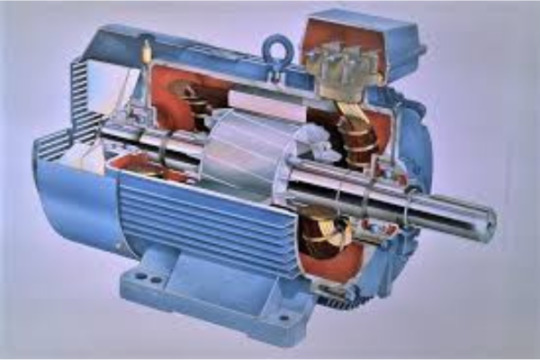
A motor on alternating current (AC) has three phases and 240 volts. AC motors can also be utilized as a generator to recharge an electric vehicle’s batteries because of their regenerative nature. This motor also has the added benefit of faster acceleration and smoother running on uneven ground. Its cost is higher than that of DC motors, which is its primary disadvantage.
The two main types of AC motors are synchronous and asynchronous motors, also called induction motors. Induction motors can be relied upon, are reasonably priced, and require little maintenance, making them simple to use. In contrast, synchronous motors offer some advantages, including strong low-speed torque, small form factor, high power density, high efficiency, and low weight.
BLDC Motors:

These motors have several benefits over AC motors, such as longer speed ranges, noiseless operation, quicker dynamic reaction times, and more. They have an exceptionally high torque ratio relative to size, making them a great fit for EVs, which require high power density yet lightweight and small form factors.
Moreover, BLDC motors require incredibly intricate hardware and software control. AC motors can store energy for braking and release it for accelerating, but they require an appropriate DC-AC inverter. This restores the essential battery juice while enabling you to drive normally. Some DC systems are more costly and sophisticated than others because they can also accomplish that.
BLDC motors require more sophisticated reversing techniques than AC motors, which can be easily reversed by simply flipping the order of the two phases in the inverter.
Both BLDC and AC motors are viable choices for powering EVs, even though AC motors are preferred when performance and long-range are critical criteria. As with many other electronics applications, the key to this selection is to find the optimal balance between cost and performance.
Algorithms for motor control

While there are many other types of electric motors, we will focus on the AC and BLDC/PMSM DC motors that are commonly seen on electric vehicles (EVs). Consequently, the motor control algorithms used in EVs will depend on the kind of motor and control (open or closed loop). The latter requires the presence of sensors that can accurately determine the position of the motor at any given time.
Trapezoidal control is among the simplest types of BLDC motor control. Even though it’s quite popular and reasonably priced, it has a torque ripple problem when driving.
Sinusoidal control is generally considered to be an improvement over trapezoidal control. The main benefits of this control are less noticeable noise, higher torque at lower speeds, and more precise and seamless operation. To accomplish these, three currents are pushed into each of the three motor windings, and these currents vary smoothly and sinusoidally as the motor rotates. Precise rotor position measurement can be achieved using encoders or resolvers to provide smooth sinusoidal modulation of the motor currents while the motor rotates.
While sinusoidal control is very successful at low motor speeds, it becomes limited at high motor speeds due to an increase in the frequency of the sinusoidal signal. At high speeds, torque production decreases and efficiency diminishes.
Originally developed for AC motors, Vector Control, often known as FOC for Field Orientation Control, is the most advanced control method available today. An electric motor’s torque is influenced by the rotor and stator fields, and it is greatest when they are orthogonal.
The FOC approach aims to replicate the orthogonal relationship present in an AC or BLDC motor. A two-orthogonal component, FOC stands for variable frequency control of the stator in a three-phase motor. One component is the torque, which is determined by the motor speed and the location of the rotor; the other is the magnetic flux produced by the stator.
Field Oriented management uses two techniques to manage torque and flux separately:
Direct FOC: From flux estimation or measurement, the rotor flux angle is directly determined.
Indirect FOC: The slip calculations and the available speed are used to deduce the rotor flux angle. When using a dynamic model of an AC induction or BLDC motor, vector control can be computed with the use of intricate algorithms and knowledge of the terminal current and voltages. However, this method requires a lot of processing power to use well.
Vector-based motor control has the natural benefit of being able to control multiple AC, PM-AC, or BLDC motors using the same scheme. The FOC technique allows brushless motors to reach up to 95% efficiency, which is efficient within the maximal speed range. Its accuracy and precise control also allow the motor speed to be decreased to almost 0 rpm.
Figure 1 is an example diagram for a three-phase BLDC motor control. Six power transistors are involved, one for each of the three phases, or three half-bridges altogether. Three PWM signals are typically used to activate them, and an MCU or integrated driver IC controls the timing and sequence of these signals. The microcontroller receives positional feedback from three Hall sensors. An analogous picture that illustrates how to control an AC induction motor is picture 2. Here, an accurate encoder interface provides the position feedback.
Sensor versus Vehicle Motor Control Unit without sensors
BLDC motors are more challenging to operate and require an understanding of the rotor position and mechanism to commutate the motor because they are not self-commutating. Measurement of the motor speed and/or motor current and a PWM signal to control the motor speed and power are two more prerequisites for closed-loop speed control.
BLDC motors achieve absolute position sensing by detecting the rotor position with specific position sensors. Consequently, costs increase and the number of cables increases. By using the motor’s back-emf (electromotive force) to estimate the rotor position, sensor-free BLDC control does away with the requirement for position sensors. For low-cost variable speed applications like fans and pumps, sensor-less control is crucial. Sensor-less control is also necessary for compressors that use BLDC motors, including those in refrigerators and air conditioners.
Position sensors are available in three main types:
Hall-effect sensors reduce design complexity and are cheap. Yet, their resolution is subpar when compared to other sensors.
Encoders are expensive and require digital processing.
Resolvers: Digital processing must be used to obtain the optimal resolution.
Resolvers and encoders are typically used in high-precision motor control applications in the automotive and industrial industries.
Motor control unit
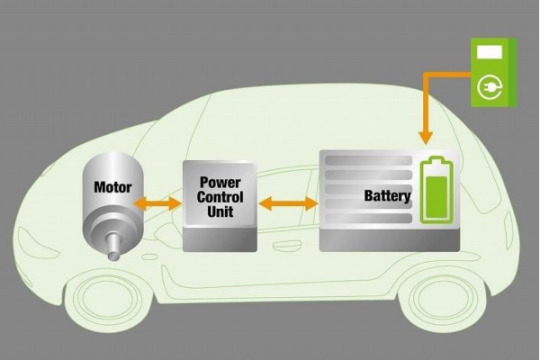
The batteries, which are DC power sources, and the motor (AC or BLDC) are interfaced with each other by an electrical module known as the Motor Control Unit (MCU). Its main duty is to control how fast and how much acceleration the EV experiences when the throttle is applied.
The following are some of an MCU’s primary responsibilities:
Control the motor’s torque and speed. Switch the engine on and off. Reverse the motor’s direction. brakes that produce energy again. When the motor is braking, it acts as a generator since the back-emf it produces is higher than the DC supply voltage to the MCU. This potential difference causes current to flow from the motor to the battery through the Vehicle Motor Control Unit.
The Vehicle Motor Control Unit uses a range of safety measures, including the following, to protect EV components:
Overvoltage: this occurs when the input battery voltage exceeds permissible limits.
Under voltage: If the MCU operates below the lower voltage cutoff, it will drain the battery more fully and may result in a thermal runaway that could destroy the cells permanently or result in a decrease in performance.
Overcurrent: If the Vehicle Motor Control Unit detects an overcurrent, it will cut off the battery supply. It does this continuously.
Overheating: as with the previous point, this happens when the internal temperature of the motor controller goes above a safe threshold.
Conclusion:
In conclusion, this overview of electric vehicle motor control provides a comprehensive understanding of the key components and characteristics that dictate how the electric motors in these cars function. Electric vehicles are crucial for reducing carbon emissions and raising energy efficiency as the automobile industry shifts to more sustainable and ecologically friendly forms of mobility.
The motor control systems — which comprise inverters, motor controllers, and several sensor types — that have been discussed form the basis of electric vehicle propulsion. The intricate relationships between these components ensure optimal efficacy, security, and performance when the car is driving. Additionally, as technology advances, motor control algorithms get better and better, providing electric car users with better acceleration, regenerative braking, and overall driving experiences.
#autonomousvehicle#MotorControlUnit#Powertrainmodelling#VCU#EVSoftware#evCODE#ADASCode#VCUSupplier#VCUManufacturer
0 notes
Text
Powertrain Component Modelling and Sizing
August 8, 2024
by dorleco
with no comment
Autonomous Vehicle Technology
Edit
Introduction
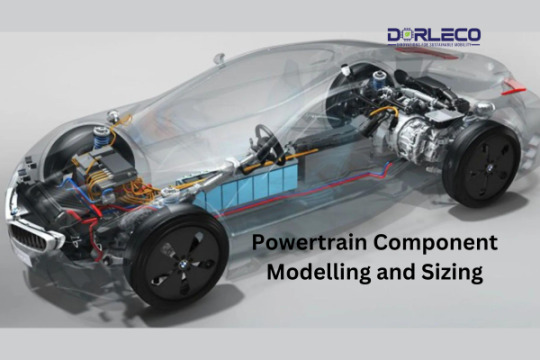
Modeling and sizing the components is one of the most crucial steps in designing a vehicle’s powertrain component system. A car’s powertrain, which typically consists of the engine, transmission, and other related components, significantly impacts the vehicle’s performance, economy, and overall functionality. Below is a synopsis of the process:
1. Describe the needs for the vehicle:
Establish the type of vehicle and its intended use, such as a truck, an electric car, or a passenger automobile.
Define the essential performance metrics, such as maximum velocity, acceleration, and towing capability.
Consider the law’s limitations, environmental regulations, and fuel economy goals.
2. Architecture of the Powertrain:
Select from an electric powertrain component architecture, fuel cell, hybrid, or internal combustion engine.
Explain the interactions between the different components of the powertrain and the energy flow that occurs inside the system.
3. Modeling Components:

Modelling Engines
Use simulation tools to model the engine’s performance characteristics, such as torque, power, and fuel consumption.
Consider issues such as engine economy, emissions, and heat control.
4. Modeling Transmissions:
To optimize gear ratios for performance and fuel efficiency, model the transmission system.
Consider factors such as gearbox efficiency, driveability, and shift times.
Electric motor and battery modeling (for hybrid and electric vehicles):
Model an electric motor’s torque-speed characteristics.
Consider output power, voltage, and capacity while modeling the battery system.
5. Modeling Control Systems:
Use control algorithms to manage energy flow, power distribution, and system performance.
Consider vehicle stability control, energy regeneration, and torque vectoring concepts.
6. Sizing and Optimization:
Dimensioning of Components
Establish the correct dimensions and specifications for each powertrain component based on the needs of the vehicle.
Optimize variables such as engine displacement, electric motor power, and battery capacity.
7. Integrity & Compatibility:
Make sure the powertrain functions as a single cohesive unit.
Consider factors such as heat management, weight distribution, and packing restrictions.
8. Validation of Performance:
Playback:
Use simulation tools to confirm the overall functioning of the Powertrain Component system under various operating conditions.
Iterate and refine the design in light of the simulation’s results.
9. Testing of prototypes:
Build functional prototypes to confirm the simulation’s findings in practical situations.
Based on test results, modify the components of the powertrain.
10. Evaluation of Costs:
Consider the budgetary impact of the chosen powertrain components.
Cost considerations ought to be weighed against effectiveness and efficiency.
11. Iterative Methodology:
Iterations are a common part of powertrain development. Modify the design in response to feedback, testing, and simulation results.
12. Documentation and Compliance:
Keep records of the design decisions, testing outcomes, and specifications. Verify that the pertinent laws and regulations are being followed.
Advantages of Modeling and Sizing Powertrain Components
When constructing a car, there are numerous benefits to modeling and sizing the powertrain components. Here are a few key advantages:
1. Performance Optimization:
Thanks to modeling, engineers can simulate and assess the performance of individual Powertrain components as well as the system as a whole.
Sizing ensures optimal performance in terms of power production, efficiency, and overall functionality by properly matching components.
2. Enhancing Efficiency:
By accurately replicating the components of the powertrain, engineers can discover solutions to improve efficiency, reduce energy losses, and maximize fuel economy.
Precise component sizing minimizes over- or under-sizing by optimizing the Powertrain Component for the particular requirements of the vehicle.
3. Lowering Expenses:
Engineers can determine the most economical configuration of Powertrain components using simulation and sizing.
Cutting down on over-specification can save costs for materials, manufacture, and the entire vehicle production process.
4. Reduction of Emissions:
Internal combustion engines emit fewer pollutants thanks to the optimization of the combustion process made possible by precise modeling.
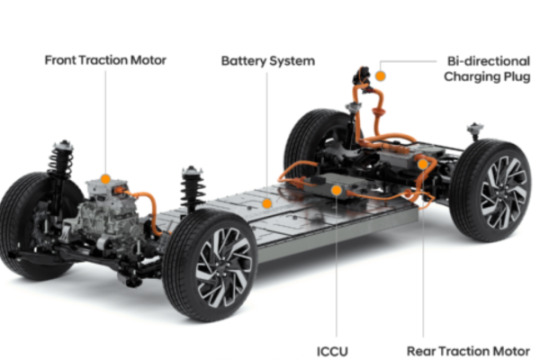
5. Analysis of predictability:
Through modeling, engineers can predict how the Powertrain Component will perform in various operating conditions without the need for physical prototypes.
This ability to foresee issues ahead of time speeds up the design process and makes it feasible to recognize and address any issues early on.
6. Personalization for Specific Uses:
Modeling and sizing facilitate powertrain modification for a range of vehicle types and applications.
Whether the vehicle is meant to be a high-performance sports car, a fuel-efficient commuter car, or a heavy-duty truck, the powertrain can be built to meet specific needs.
7. Enhanced Energy Management (in Electric and Hybrid Cars):
Modeling aids in the energy management strategy’s optimization in electric and hybrid cars. This covers controlling the distribution of power overall, regenerative braking, and battery charging and discharge.
If the electric components are sized appropriately, the car can achieve the necessary performance and range.
8. Shorter Time for Development:
The simulation-based design allows Powertrain Component iteration and refinement more quickly than traditional trial-and-error methods.
This reduces the overall development time of the vehicle.
9. Enhanced Durability and Reliability:
By using simulation, engineers can assess the mechanical and thermal stresses placed on powertrain components and make sure they are designed to withstand real-world scenarios.
Proper size of components aids in avoiding premature wear and failure.
10. Adherence to Regulations:
By applying modelling, engineers may design powertrains that comply with safety, fuel efficiency, and emissions laws.
This preventive measure enables manufacturers to avoid costly recalls and redesigns.
Disadvantages of Sizing and Modeling Powertrain Components

1. The complexity of the model:
Making realistic models of every part of the powertrain and their interactions can be challenging and time-consuming. For detailed modeling, a complete understanding of the thermodynamic and physical properties of the components is required.
2. Validation and Accuracy of Data:
The correctness of the simulation findings is mostly dependent on the caliber of the input data and the dependability of the mathematical models used. The validation of these models requires time-consuming and expensive real-world testing.
3. Integration Difficulties:
It can be difficult to integrate different powertrain components into a coherent system, particularly in hybrid and electric vehicles where many technologies (such as engines, electric motors, and batteries) must function seamlessly.
4. Conditions of Dynamic Operation:
Powertrains operate in a range of dynamic conditions. Severe weather patterns, sudden variations in load, and ephemeral behaviors could be too complex for size and modeling to capture.
5. Limited Simulation Scope:
Simulations are based on assumptions and simplifications. Certain aspects of driving in the actual world, like changing traffic patterns and road conditions, might not be sufficiently accounted for in simulations.
6. Simulation Software’s Initial Cost:
Purchasing and utilizing advanced simulation tools can be costly. It could be challenging for small or new enterprises with limited funding to get modern modeling software.
7. Human Factors and Experience Driving:
While modeling often focuses on technical aspects, it may overlook crucial features or the driver’s subjective experience. Probably, features like comfort, loudness, and vibration aren’t given enough consideration.
8. Rapid advancements in technology:
Technology is advancing quickly in the automotive industry, especially in the domains of electric and driverless cars. Models may become outdated due to new technologies, requiring constant changes.
9. Ambiguity in the parameters entered:
Many of the input characteristics utilized in modeling, such as environmental elements, traffic conditions, and driver behavior, can have a great deal of uncertainty. These uncertainties could affect how accurate the forecasts are.
Conclusion:
To sum up, engine component sizing and modeling are crucial to the design and development of contemporary cars. They come with several advantages as well as difficulties. The ability to simulate and improve the functioning of individual components as well as the entire drivetrain system results in more efficient, cost-effective, and low-emission solutions. Engineers can meet legal requirements and provide the best possible performance by tailoring the powertrain to a particular vehicle’s requirements.
It’s crucial to recognize the difficulties and restrictions this strategy has, though. A flawless simulation is unattainable due to the complex nature of modeling, difficulties with data validation and accuracy, and the dynamic working circumstances of automobiles. The complexity is increased by integrating different powertrain technologies, responding quickly to changes in the industry, and handling input parameter uncertainty.
It’s critical to strike a balance between simulation and in-person testing. Even while modeling speeds up the design process and offers insightful information, physical testing is still necessary to confirm simulation results and guarantee the powertrain’s dependability and safety under a variety of circumstances.
Powertrain modeling and sizing will probably become more important as the automotive industry develops, particularly in light of the developments in electric and autonomous car technology. Future vehicle powertrain design and development can be made more innovative and efficient by addressing some of the current issues through continued study, cooperation, and standardization. In summary, when applied wisely, powertrain component modeling and sizing are effective techniques that help engineers design cars that are not just cutting edge in terms of technology but also dependable, sustainable, and well-suited to a wide range of customer requirements.
0 notes
Text
An Introduction to Systems Engineering
August 7, 2024
by dorleco
with no comment
eMOBILITY CONTROLS
Edit
Introduction
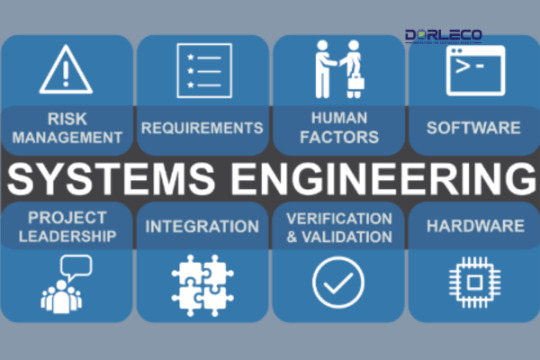
Systems engineering is a systematic, comprehensive approach to organizing, designing, and managing complex systems at every point of their life. To build, assess, and improve systems that meet predefined standards, this field of study blends project management with a range of engineering skills. In addition to considering a system’s technical aspects, system engineering also considers its larger aspects, such as cost, scheduling, safety, and sustainability. Here is a summary of a few fundamental ideas in system engineering:
1. Systems Definition:
In the discipline of systems engineering, a system is described as a collection of interconnected pieces or components that work together to accomplish a specific goal. These components could be intangible (like software or organizational procedures) or tangible (like engines or sensors).
2. Essential System Engineering Principles:
Comprehensive Method: Systems engineers consider the system as a whole, taking into consideration all of its parts and how they interact, as opposed to focusing on individual components.
Requirement analysis: Accurately determining and managing demands is a crucial part of system engineering. This means understanding and documenting the objectives the system has to achieve in addition to the constraints it needs to operate inside.
Iterative Process: Systems engineers often go through iterative cycles of design, analysis, and refinement to ensure the system meets its objectives.
Interdisciplinary Collaboration: Systems engineers work with experts from a variety of fields to address complex problems and offer solutions.
3. Life Cycle of Systems Engineering:
Systems engineering has a systematic life cycle with multiple stages, including:
Concept Development: Defining the objectives and first concept of the system.
System Design: Developing the system’s intricate architecture and design. Verifying that every component of the system functions as intended is the goal of testing and system integration. The system’s operation and maintenance are managed throughout its operation.
4. Procedures for systems engineering:
Systems engineers follow protocols and approaches to manage the complexity of system development. These processes include:
5. Engineering Requirements:
Assembling and managing the specs for the system.
The process of representing and analyzing a system with modeling tools and approaches is called system modeling and simulation.
6. Validation and verification:
Ensuring that the system meets its requirements and performs as planned.
The process of identifying, assessing, and minimizing systemic risks is known as risk management.
7. Instruments and Methods:
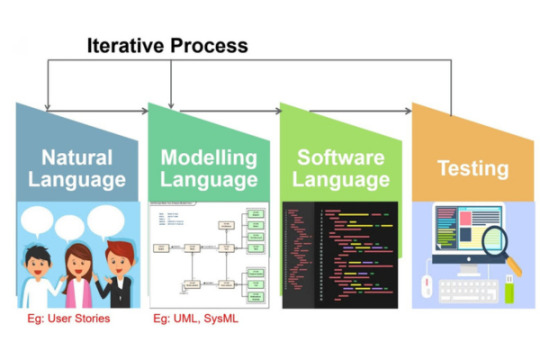
8. Systems Engineering Applications:
Among the industries that use system engineering are information technology, energy, transportation, aerospace, defense, automotive, and healthcare. It is used in the development of complex systems such as satellites, aircraft, transportation networks, and medical information systems.
9. The Concept of Systems Thinking
Systems thinking, or looking at the system as a whole and determining how actions or alterations in one area of the system may affect other areas, is a technique used by systems engineers. Understanding how interrelated the system is is emphasized heavily.
Systems Engineering’s advantages
Systems engineering offers several benefits to organizations and projects that design, develop, and manage complex systems. These benefits arise from its systematic and all-encompassing approach to managing a system’s whole life cycle and resolving issues. Among the principal advantages of system engineering are the following:
Holistic Approach: System engineering looks at all facets of the system, considering each component and how it functions as a whole. By keeping the “big picture” in mind, this approach helps solve complex problems.
Risk management: Including risk management is a crucial part of systems engineering. Early risk assessment, identification, and mitigation reduces the likelihood of future costly issues.
Optimized Design: By using modeling and simulation tools, system engineers may assess a wide range of design possibilities and make well-informed decisions to enhance system performance and cost-effectiveness.
Multidisciplinary Collaboration: Systems engineering encourages collaboration between experts in several domains. This promotes original thought and leads to a deeper understanding of the system.
Improved Communication: Systems engineering assists project participants in communicating clearly so that all parties are aware of the goals, constraints, and current state of the project.
Enhanced Flexibility and Adaptability: By facilitating improved management of modifications and adjustments throughout a project’s life cycle, systems engineering mitigates the impact of unforeseen events or changing needs.
Sustainability: Systems engineers can reduce systems’ long-term environmental consequences and design more environmentally friendly systems by considering lifecycle evaluations and environmental sustainability.
Drawbacks with Systems Engineering
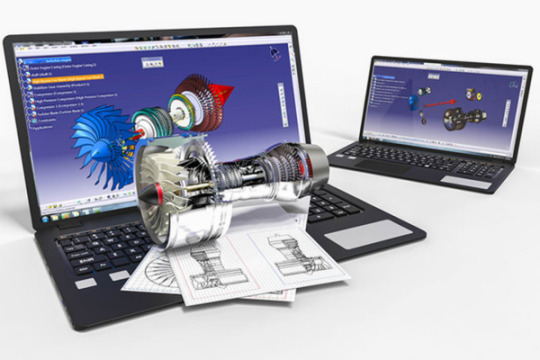
While there are many advantages to system engineering, there are also challenges and disadvantages. Among the potential drawbacks of systems engineering are the following:
Complexity: Managing complex systems and related processes may be challenging. Systems engineering is a difficult field that requires a lot of work for organizations or projects with limited funding. It also calls for a great degree of expertise.
Time-consuming: Because systems engineering emphasizes meticulous modeling, analysis, and documentation, it can be a laborious process. This could lead to project delays, which is unacceptable for companies that need to complete tasks quickly.
Resource-intensive: The execution of systems engineering typically necessitates the use of additional resources, including trained people, specialized software, and equipment. Allocating these resources to smaller groups or initiatives with more limited funding could be challenging.
Opposition to Change: Groups or individuals accustomed to using more traditional engineering approaches could find it difficult to accept systems engineering methodologies. It can be quite challenging to overcome opposition and implement cultural change.
Over-Engineering: To address all possible requirements and contingencies, systems engineering can occasionally lead to over-engineering, which increases costs and complexity without offering comparable benefits.
Rigidity: Some critics of systems engineering claim that it can be rigid and unyielding, particularly when dealing with rapidly developing technology or shifting project requirements.
Complex Documentation: Focusing heavily on documentation can often lead to a lot of paperwork, which some team members may find burdensome or unnecessary.
Communication Challenges: Good communication amongst interdisciplinary teams is crucial in system engineering, but it can be challenging because various subject specialists have distinct vocabularies and points of view.
Scope Creep: Systems engineering may not always be able to fully prevent scope creep, and it may occasionally be difficult to handle changes effectively, leading to additional costs and project delays.
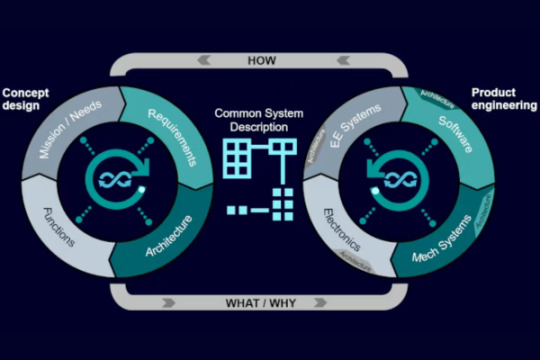
Conclusion:
To sum up, system engineering is a useful and essential field for addressing the complexity of contemporary technological and technical problems. It provides a methodical and comprehensive approach to complex system design, development, and administration across a range of sectors and uses. Even though it has several difficulties and possible negative aspects, the advantages it offers greatly exceed the downsides.
Systems engineering encourages multidisciplinary cooperation, efficient risk management, a firm grasp of system requirements, and optimum design. These benefits result in better project outcomes as well as lower expenses, higher quality, and long-term viability. Systems engineering makes sure that systems are not just well-designed but also long-lasting and flexible by taking care of the full system life cycle, from concept creation to operation and maintenance.
Systems engineering is an essential technique for assuring the effective development of systems that accomplish their intended objectives while taking into account the broader context of resources, time, and stakeholders in an era of ever-increasing complexity and interconnectedness. It helps businesses to confidently manage challenging projects, make wise choices, and provide excellent, reasonably priced solutions that benefit society as a whole.
1 note
·
View note